Brazil, August 2007
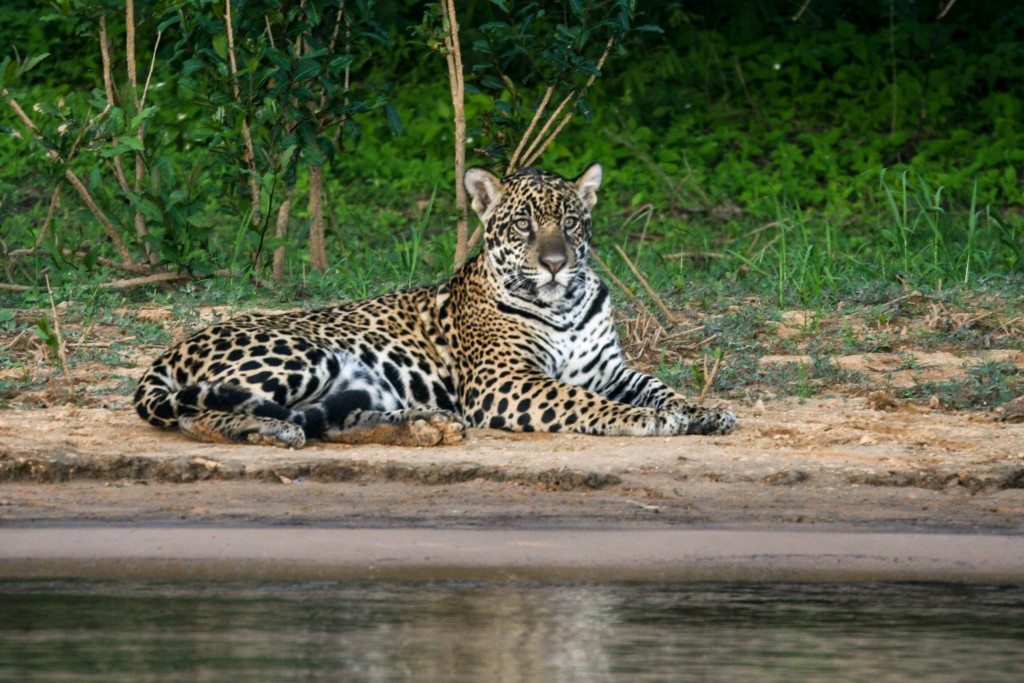
Jaguar, Panthera onca, Porto Jofre
If you ever travel on Portugal’s TAP airlines and have just 30 minutes to make a connection in Lisbon then you are right to be sceptical that your luggage won’t connect with you. The person in front of me at check-in queried this and was told “there is no problem, your luggage is checked straight through”. I had been told precisely the same thing the day before over the phone. This must be the first phrase TAP staff are taught to memorise during induction training. Perhaps it is no problem for TAP, but it was a problem for everyone who had been on that connecting flight from Heathrow to Lisbon when we landed in Sao Paulo without our bags.
I organised this trip by copying the itinerary Richard Webb had developed over several years through the WildWings/Predatours trips (various reports are linked to the Brazil summary page). I also added on three nights at Rio Cristalino in the Amazon at the start, plus a day in the state of Espirito Santo at the end.
I used Brasil Aventuras Expedições as the local ground agent. Homero Brasil Neto from there is brilliantly efficient, speaks perfect English and was also fabulous at reuniting me with my luggage. On Richard’s advice I used a couple of local guides. Eduardo from Pousada Jaguar in the Pantanal, and Regina Ribeiro in Minas Gerais. They were both excellent company, knowledgeable, and ready to work long hours in the field: I recommend them without hesitation.
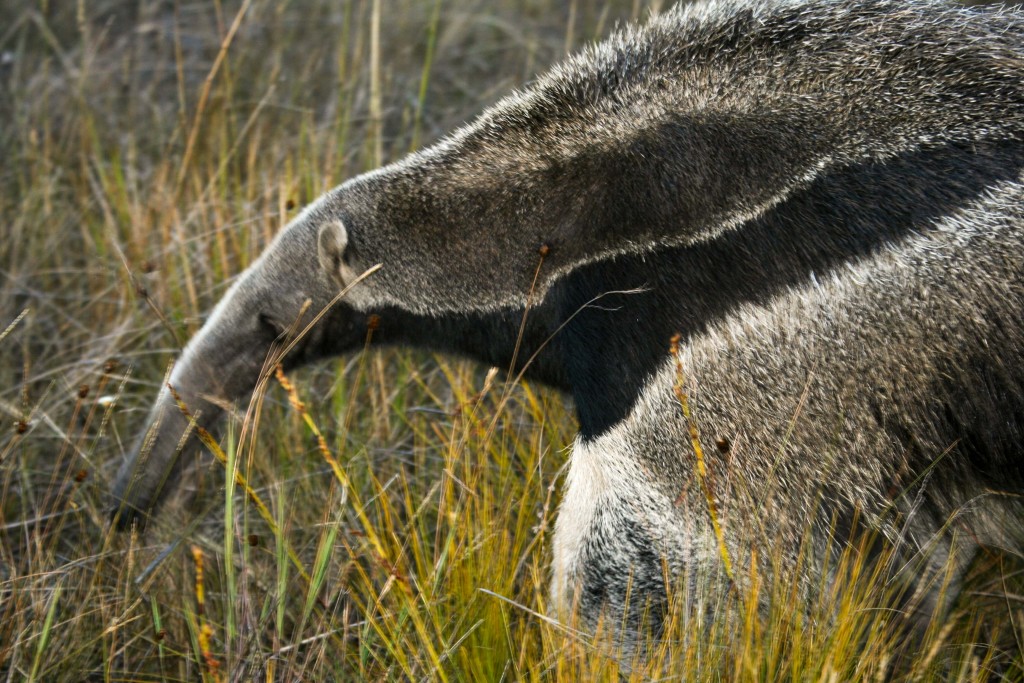
Giant Anteater, Myrmecophaga tridactyla
Internal air travel in Brazil is a challenge. The planes seem safe enough but timetables are more of a suggestion than a schedule. Leave plenty of time for connecting flights internally. Brazilian flights seem to be on time until boarding is about to commence at which point the gate number changes randomly and the flight is delayed. If I hadn’t have lost my luggage coming into Sao Paulo I feel sure it would have gotten lost between there and Cuiaba that same day. Every flight I took was delayed and one had me redirected to a military airbase 150km from where I wanted to be.
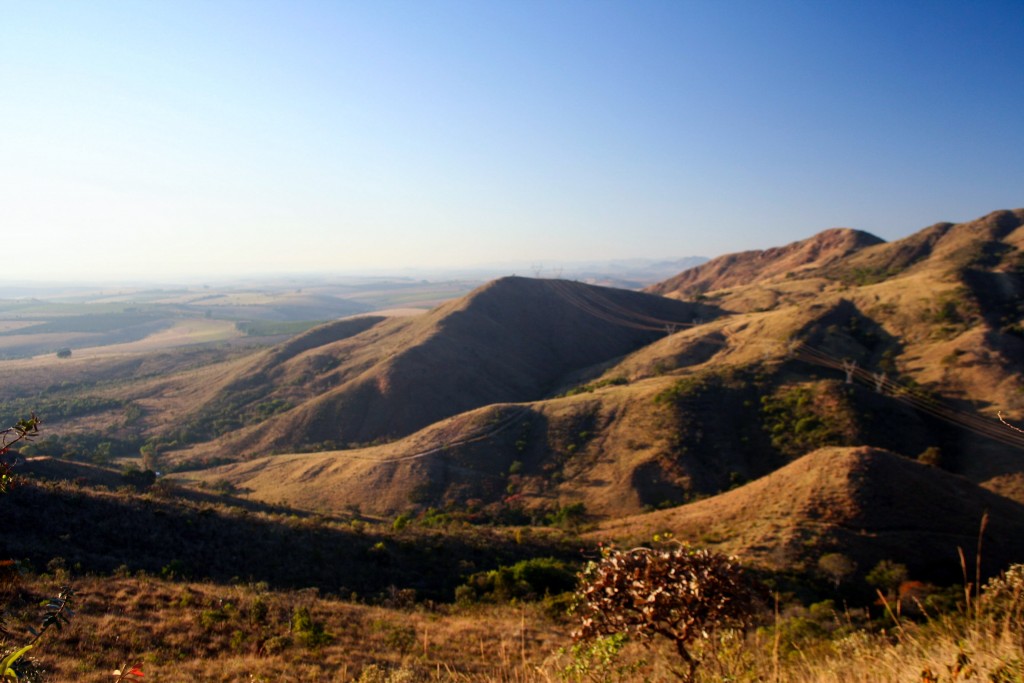
Canastra National Park
Twenty four hours and four flights after leaving London I was at Cuiaba airport trying to get an ATM to work (Brazilian ATMs don’t work well with foreign cards even though they should) and wondering if I would ever see my luggage again. The next morning I flew to Alta Floresta, was met at the airport and driven for an hour to the banks of the Rio Cristalino where a 20 minute boat ride delivered me to the lodge.
Rio Cristalino
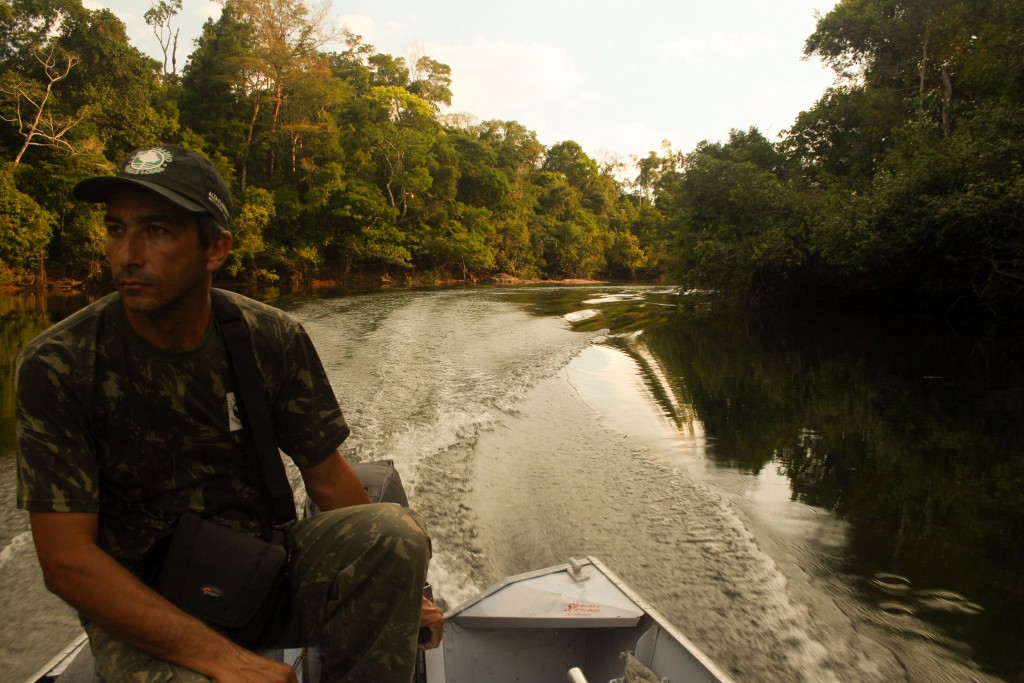
Day 1
I hesitate to use the word pristine, but the forest round Rio Cristalino is up there with the best I have seen. They have a good range of Amazonian mammals and birds, and many seem to be at levels of abundance similar to what they would have been in the past. I was assigned Jorge as my guide – he was the lodge’s mammal expert and was excellent. He didn’t speak English but my few words of Spanish were enough for us to communicate and he knew the Latin names for most of the mammals. He was also very good at catering to my wishes in trying to find certain species (and here is a list of species at the lodge).
I had a quick walk when I arrived and saw my first White-Whiskered Spider Monkeys (Ateles marginatus) near the lodge, and these were the primates we saw most often. Before dinner Jorge found me several Azara’s Night Monkeys in the trees right by the restaurant (some believe these are a separate species, Feline Night Monkey, Aotus inflatus).
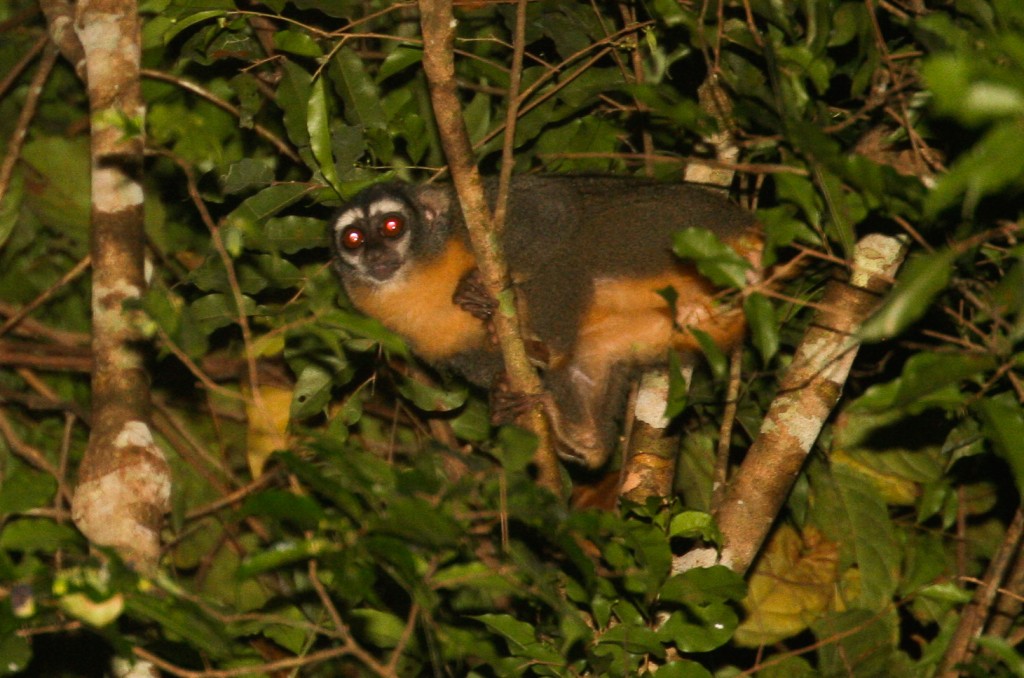
Azara’s Night Monkey, Aoutus azarae inflatus
After dinner we visited the natural salt lick (saleiro) about a kilometre from camp, overlooked by a small tree platform. As we sat down it was obvious that a large mammal was nearby and Jorge told me it was a tapir. We waited for half an hour – until it was right below us – before Jorge turned on his light and sure enough there was my first Brazilian Tapir. It hung around for about 3 seconds. There was at least one other largish mammal nearby that we heard but didn’t see.
Day 2
The next morning we walked the trails near camp looking for primates starting with the Rocky Trail. After about 15 minutes we heard some White-Nosed Bearded Saki Monkeys that gave us good views. They were travelling close to some Brown Capuchins. A large troop of White-Whiskered Spider Monkeys were nearby.
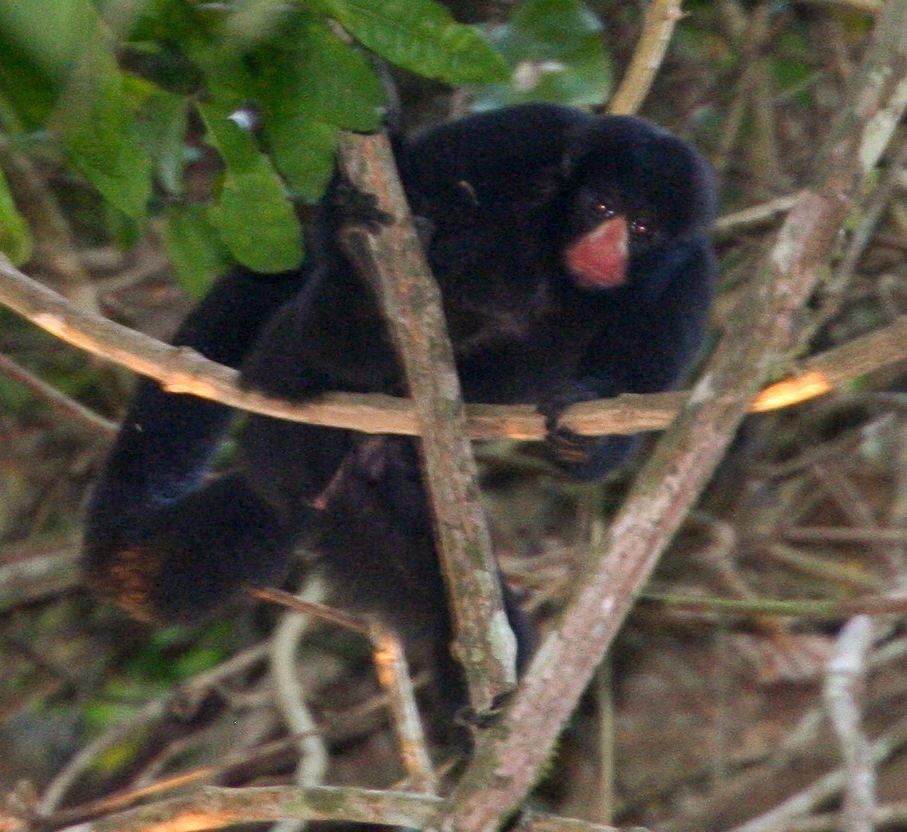
White-nosed Bearded Saki, Chiropotes albinasus
A little further along the trail we saw a large troop (I counted 11 animals) of Red-Handed Howler Monkeys.
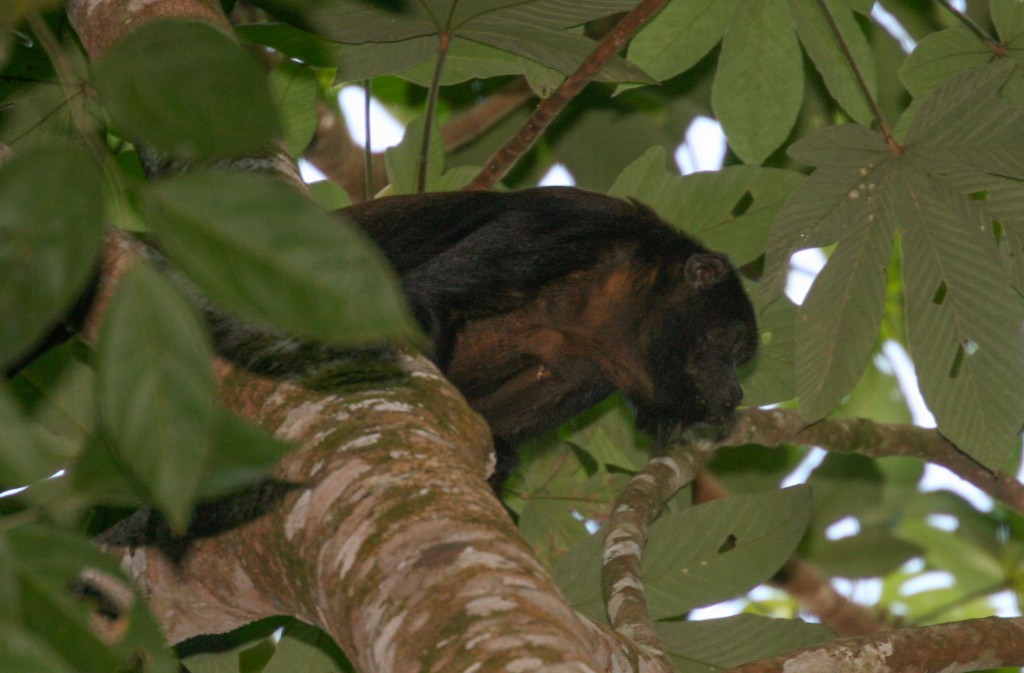
Red-handed Howler, Alouatta discolor
We spent another few hours wandering along various creek beds and animal tracks looking for White-Lipped Peccaries, a species that is relatively common in the area but which I didn’t see despite considerable effort. There were plenty of tracks though.
Lesser White-Lined Bats (Saccopteryx leptura ) were roosting under the eaves of the building next to the restaurant.
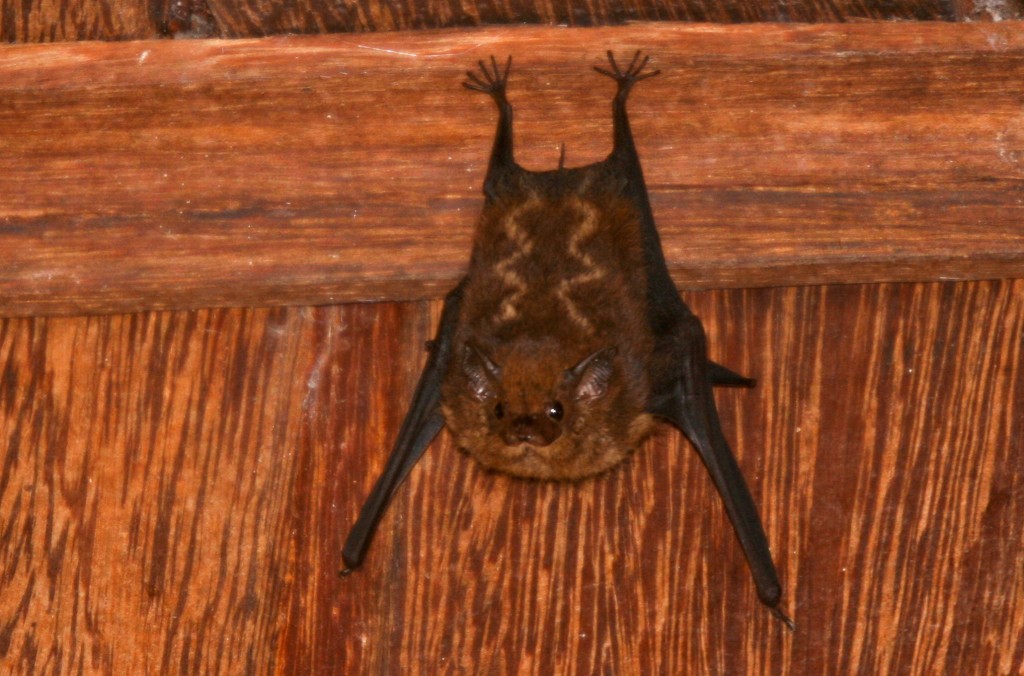
Lesser White-Lined Bats, Saccopteryx leptura
In the afternoon we took a boat along the river and saw a lot of birds, some more spider monkeys drinking from a pool and my first Capybaras.
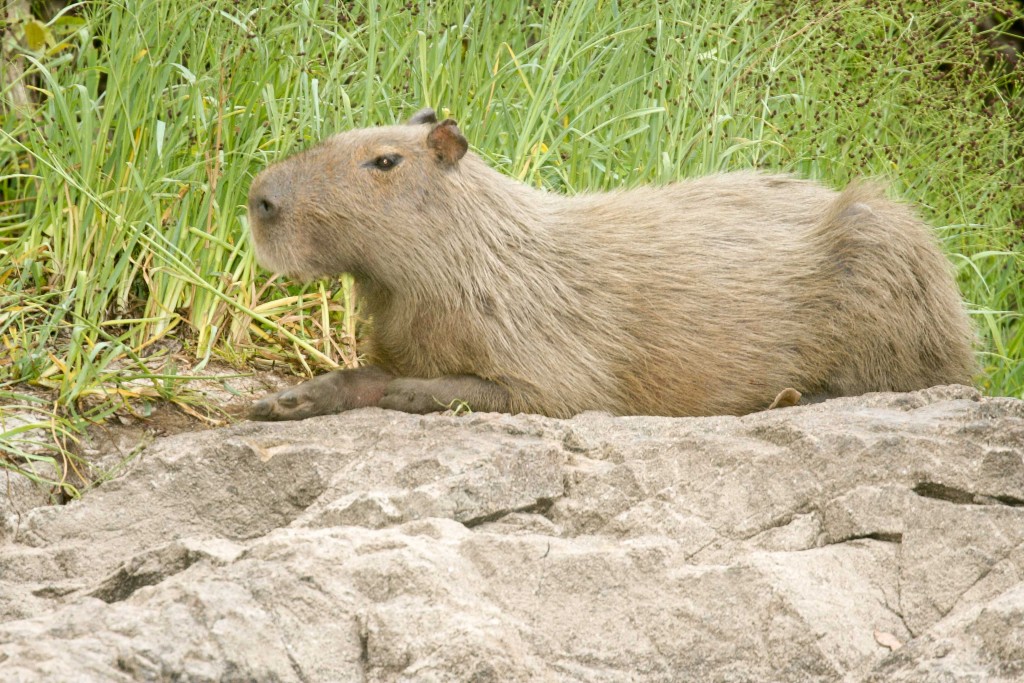
Capybara, Hydrochoerus hydrochaeris
We stopped at another small hide overlooking a salt lick on the way back and spent an hour there as night fell. Nothing showed. That evening I borrowed a torch (my spotlights were in my luggage that was allegedly in Brazil but not in Rio Cristalino) and wandered the trail for an hour. I heard what was probably an armadillo but didn’t see it or any other mammals.
Day 3
Saki and spider monkeys were next to the lodge the following dawn. We set off at 6 a.m. in search of Dusky Titi Monkeys that are harder to find than the monkeys I had already seen. Jorge had a tape player and we took the boat upstream to the start of the Dr Heller’s Trail where Jorge had heard titis recently. A Grey Brocket Deer crossed the start of the trail. Fifteen minutes later we heard some titi monkeys calling close by. They responded well to the tape but while easy to hear they were very hard to see: they moved cryptically but I got a few brief glimpses.
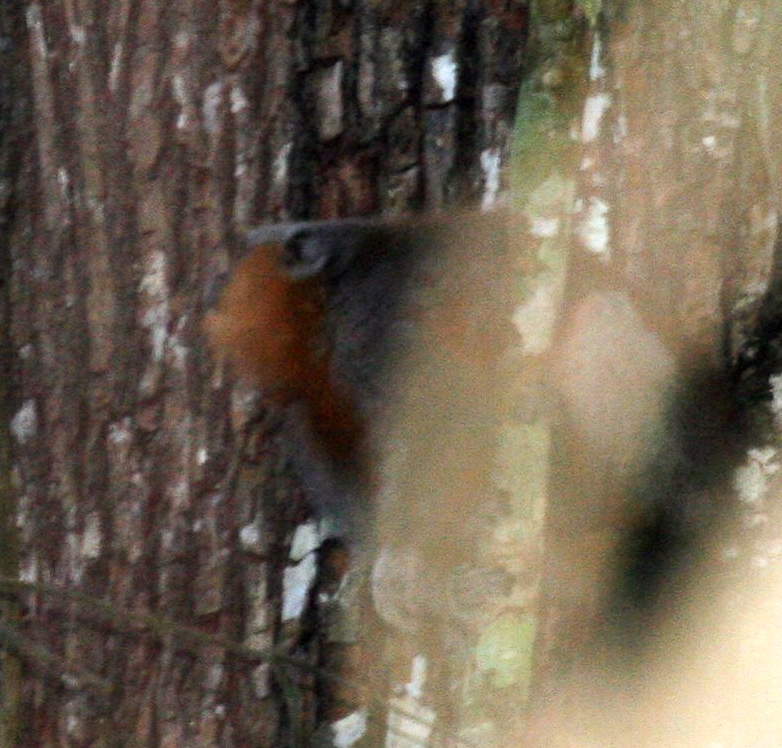
Dusky Titi Monkey, Callicebus moloch
We spent the rest of the morning wandering along more creek beds. No more mammals other than a few spider monkeys but plenty of birds. Back at camp we heard that one of the groups had seen a black Jaguar swimming across the river early that morning.
Jorge was anxious to keep trying for peccaries so we skipped the usual siesta and heard off to the salt lick and surrounding trails straight after lunch. No peccaries but some spider monkeys put on a nice display of disgruntled tree shaking when they noticed us.
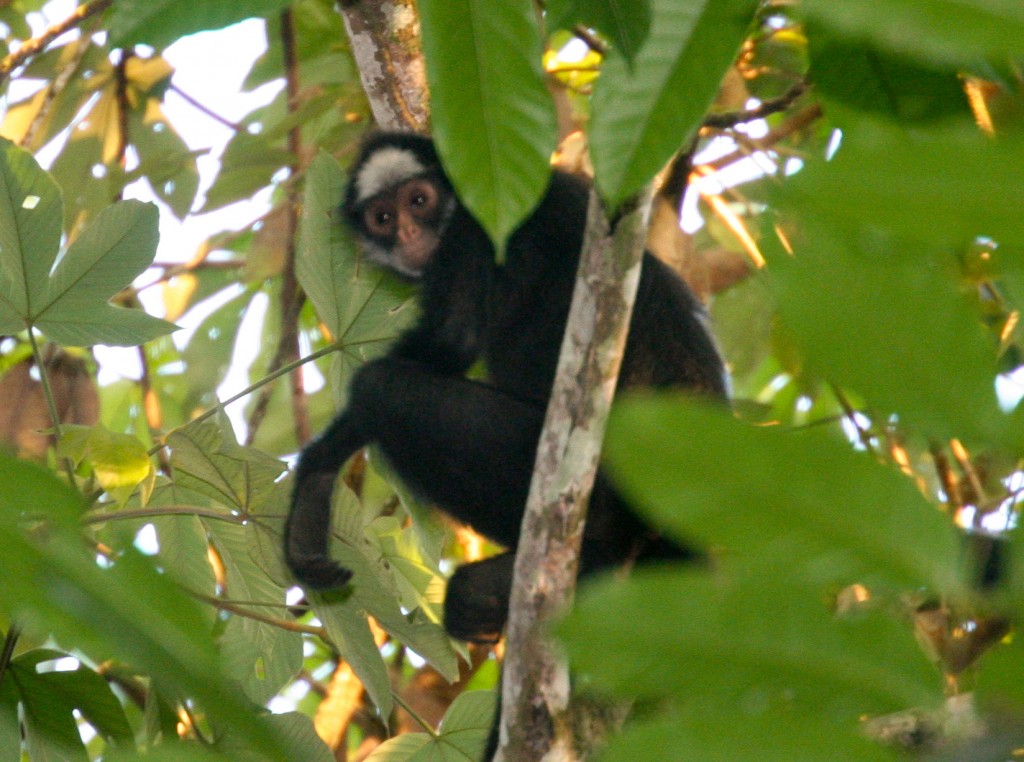
White-Whiskered Spider Monkey, Ateles maginatus
At 16.00 we took a boat upriver with a plan to spotlight on the way back to camp to look for Pacas in particular. It was a great few hours. About half an hour upstream we spotted a Neotropical River Otter that seemed unconcerned by our presence.
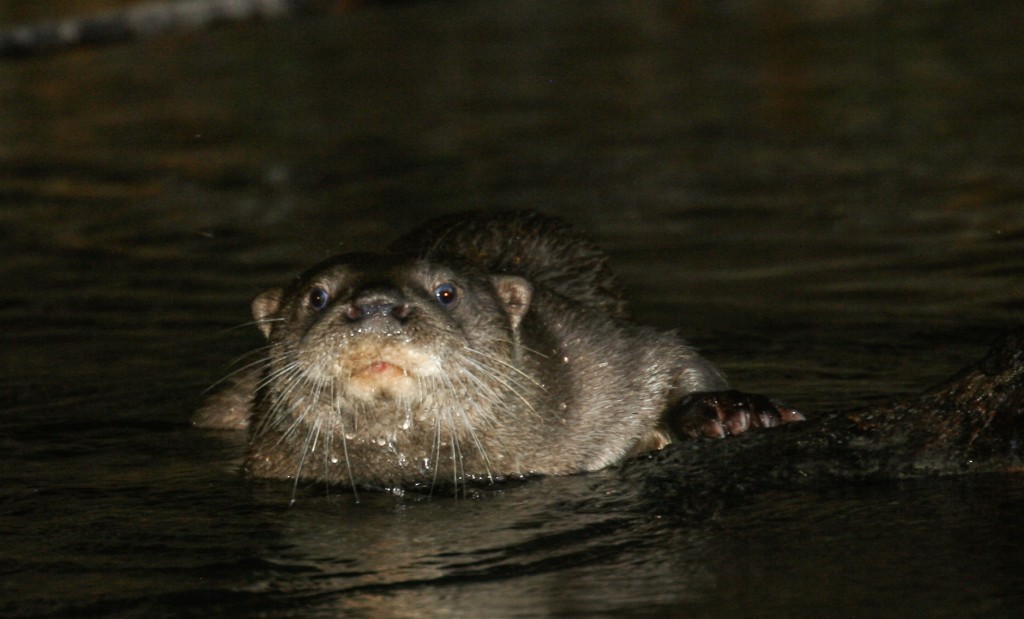
Neotropical River Otter, Lutra longicaudis
A quarter of an hour later Jorge spotted a Tapir in the edge of the river, which again didn’t hang around long enough for me to take a photo. Jorge put the spotlight on as we drifted back to camp and we saw a lot of birds, a very nice snake (which I am told was probably a juvenile Emerald Tree Boa) and two fabulous Pacas (both a little after 19.00). Pacas are often tricky animals to find, presumably because of their status as haute cuisine, but Jorge said they were pretty easy to spot along the Cristalino at night.
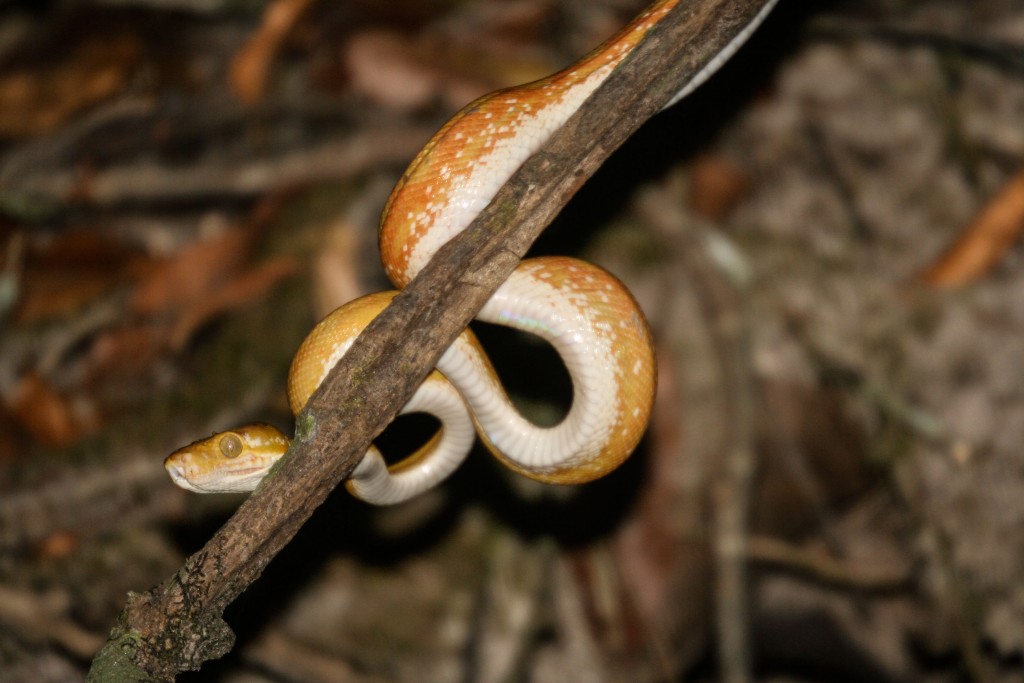
Emerald Tree Boa
Happy with my Paca I opted for an evening of capiroskas rather than further spotlighting (besides I didn’t have a spotlight).
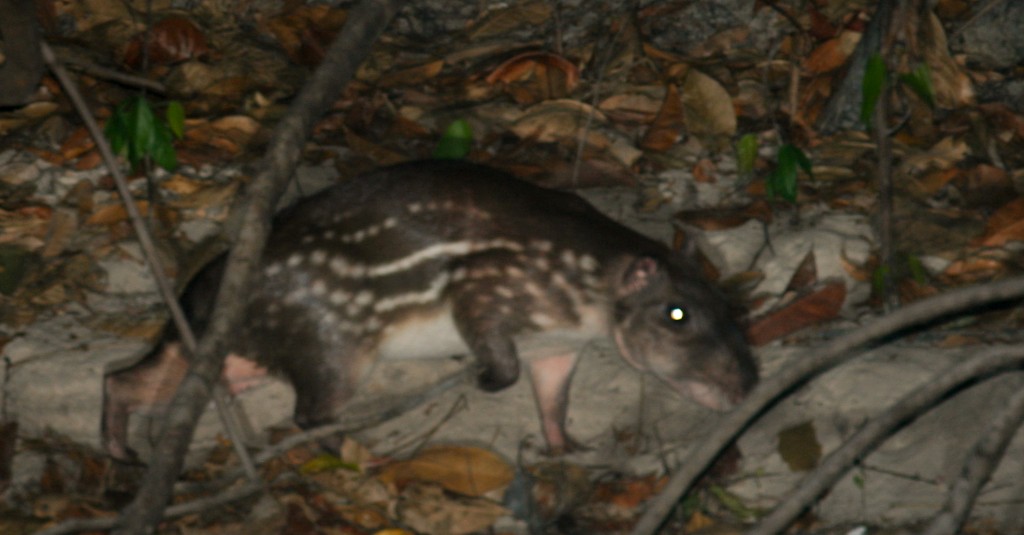
Paca, Cuniculus paca
Day 4
The next morning I’d planned to leave early for the Alta Floresta Hotel so I had a few hours before my flight to look for both Azara’s and Red-rumped Agoutis (apparently very common) as well as a try to see Silvery Marmosets (which were rare in Cristalino but quite common at the hotel). But a final walk around the trail took a bit longer than I’d planned and we didn’t head out of camp until 08.30. I got to the Alta Floresta hotel by 10.00 but there was no local guide there who knew anything about the animals and it was very hot. So during a couple of hours of fruitless trail walking I saw nothing, though I heard what I guess was an agouti. Apparently the agoutis graze by the hotel pool in the early morning.
So a good few days. I saw quite a lot and don’t think I was particularly lucky to do so. The trails close to the lodge – the Rocky Trail in particular – seemed very good for primates in the mornings. While the river in the late afternoon was good for otters, tapirs, Pacas and so on.
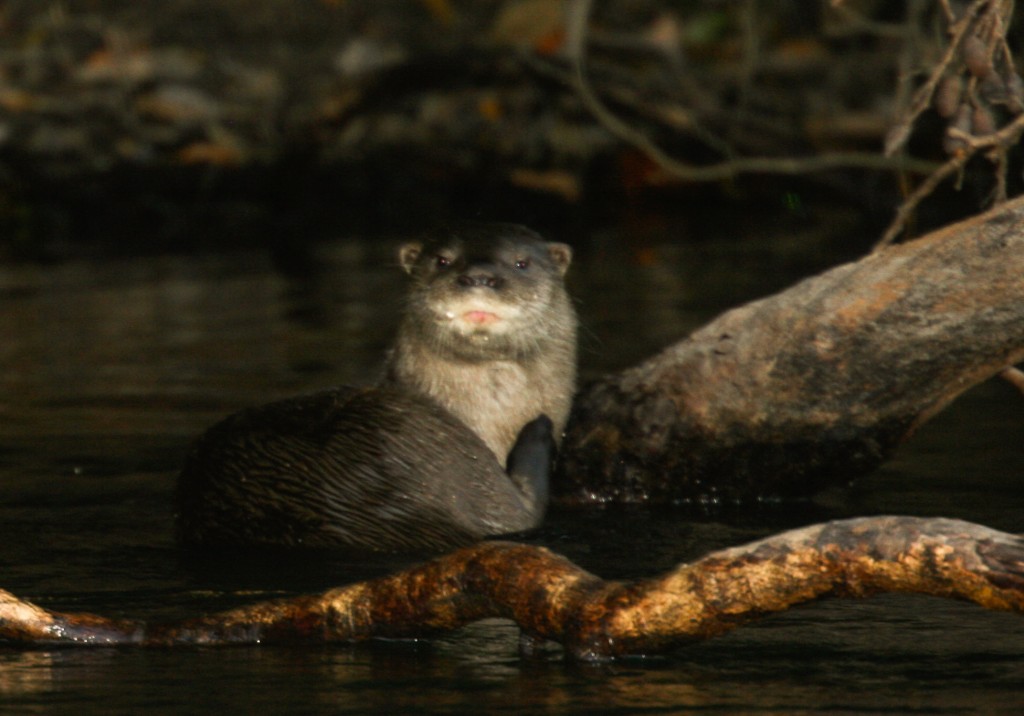
Neotropical River Otter, Lutra longicaudis
Stuff I Missed
There are a lot of mammals living in Cristalino that I might have seen although most are not often sighted. They include Nine-banded Armadillos (seen by one group at dusk while I was there), Jaguar (seen rarely though one was seen while I was there), Giant Otters (seen regularly), Red Brocket Deer, both Red-Rumped and Azara’s Agoutis (I heard what I guess were agoutis at least twice while I was there), Guianan Squirrel (common on one tree near camp apparently), Long-nosed Bats (that have a well known roost on the river upstream from camp but which I didn’t hear about until I was leaving), Southern Tamandua and Tayra. Sloths are seen occasionally at night and Giant Armadillos are also seen from time to time (we saw their holes). White-lipped Peccaries are also common in the area and it was disappointing to see so many tracks, and even to smell them, but not see the animals. A list of mammals around the lodge is here.
At the Alta Floresta Hotel it is apparently easy to see both Agouti species in the forest fragment at the hotel. Red Howler Monkeys are also easy to see there. Silvery Marmosets are less easy to see but findable.
The Pantanal
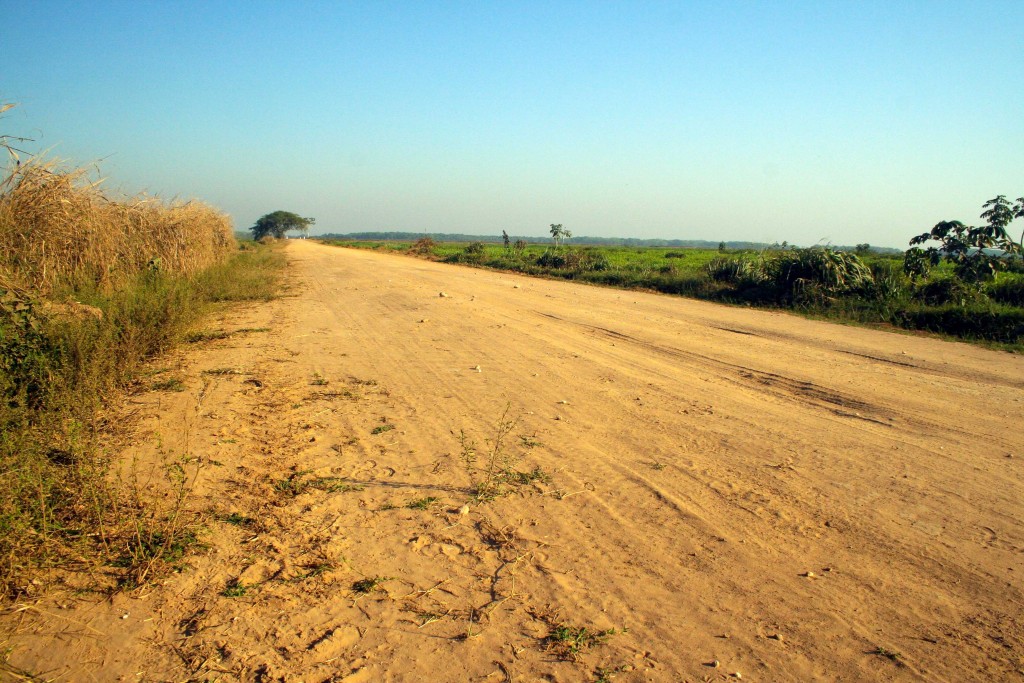
The Transpantaneira
Back in Cuiaba I was met by Eduardo from Pousada Jaguar and reunited with my luggage. Never has clean underwear given me so much pleasure. After tracking down an ATM that would eventually accept my HSBC card (on about the 10th attempt) we were on our way.
The Pantanal proper begins at the town of Pocones about 45 minutes south of Cuiaba. From there the highway – the Transpantaneira – runs 150km south, finishing at Porto Jofre. Eduardo fixed up a seat on the back of his ute, plugged in the spotlight and we set off down the Transpantaneira at 7.30pm. Although the day had been warm the evening was surprisingly cool in the back of the ute. But the animals came thick and fast. Soon after hitting the dirt I saw my first Marsh Deer. Then came the first of 10 or so Crab-Eating Foxes followed by a Crab-Eating Raccoon (we saw a couple of others later on). Capybaras were sitting on the side of the road and some of the ponds were lit up like a Christmas tree from the eyeshine of Caimans. About 25km down the road Eduardo spotted a Southern Tamandua and though it headed into the bushes right next to the truck it unfortunately didn’t continue to cross the road.
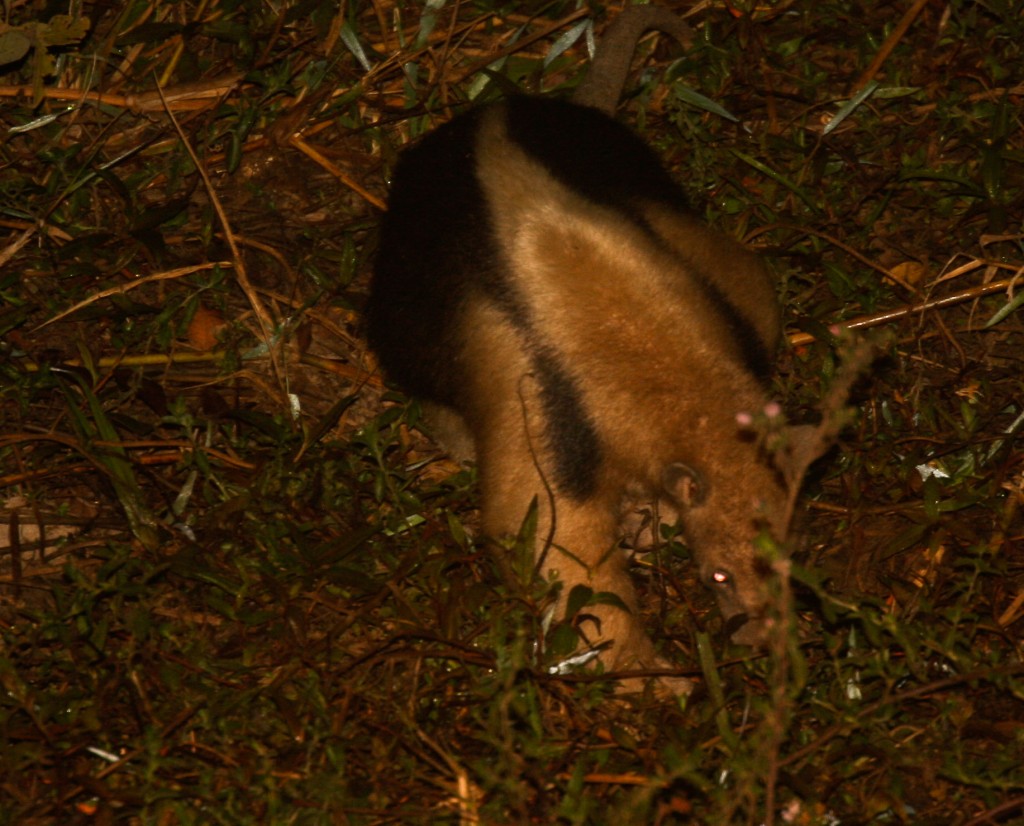
Southern Tamandua, Tamandua tetradactyla
Just before Araras Lodge and right next to the “Giant Anteater Crossing Here” sign Eduardo spotted a Giant Anteater close to the edge of the road. I had seen this species once before in Colombia but at considerable distance so it was fabulous to get a closer look.
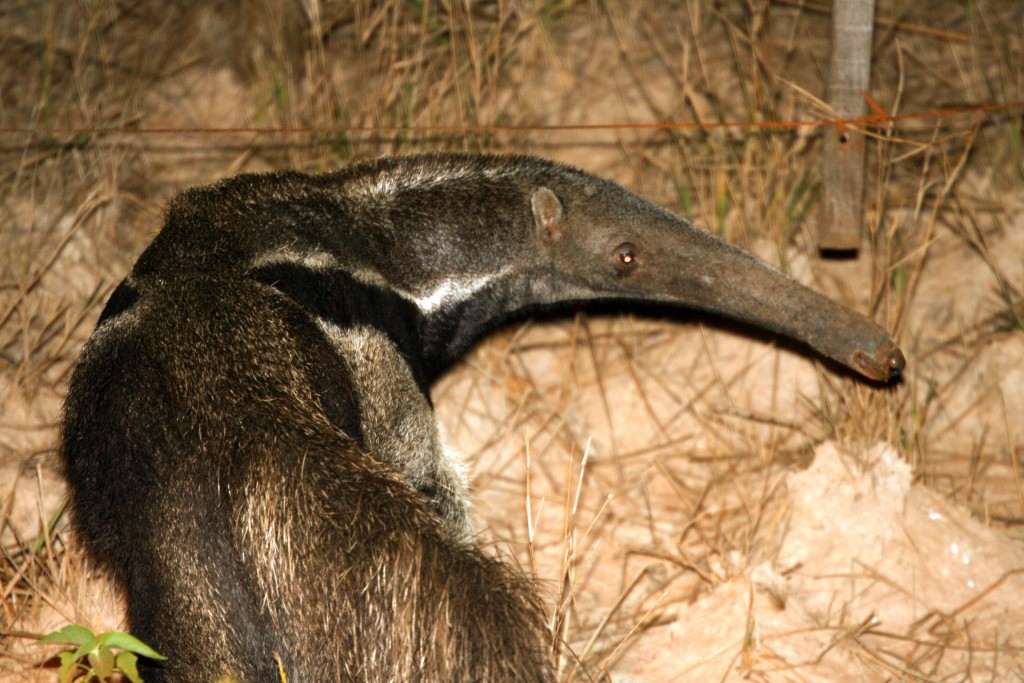
Giant Anteater, Myrmecophaga tridactyla
A few kilometres further on we saw a Red Brocket Deer, the last new species of the evening if you don’t count the Collared Peccary we saw about a kilometre down the drive to the Rio Claro Hotel (this turned out to probably have been the hotel pet).
Day 5
At 6 a.m. next morning we took the hotel’s boat along the river to look for the family of Giant Otters that had recently taken up residence downstream. On the way we saw three groups of Black Howlers, as well as some Black-Tailed (soon to be split as Pantanal) Marmosets and a single Hooded (Azara’s) Capuchin.
A Neotropical River Otter swam alongside the boat for a while. And of course there were hundreds of birds and a few of the ever present Capybaras. We found the Giant Otters at about 8 a.m. near to their holt. We watched the five youngsters and two adults fishing for a few minutes before the boatman decided that they shouldn’t be disturbed any more.
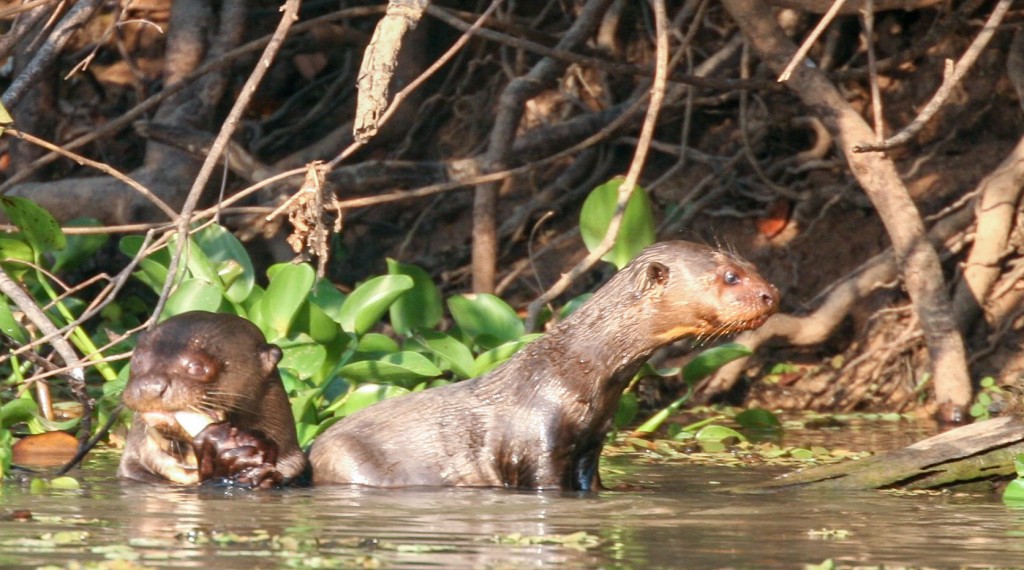
Giant Otters, Pteronura brasiliensis
Almost back at the hotel we stopped to look at a roost of beautiful – and beautifully camoflauged – Long-Nosed (Proboscis) Bats (a species I had missed at Cristalino). Easy to identify from their white tufted forearms.
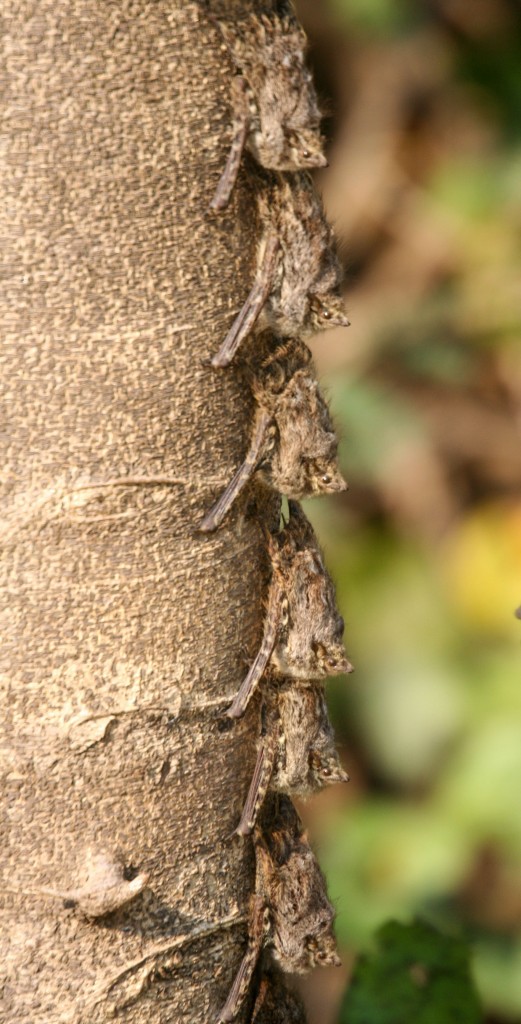
Long-nosed Proboscis Bat, Rhynchonycteris naso
After breakfast we walked along the river bank for an hour or so and saw another group of Pantanal Marmosets at close range. They kept up a continuous – birdlike – chirruping as they moved through the trees. By 10.30 a.m. it had gotten pretty warm so I retired to the safety of my hammock.
At 4 p.m. we left to drive the 20km to the Rio Pixiam, and our hotel for the night. There was another Red Brocket Deer and a second Giant Anteater near the gate.
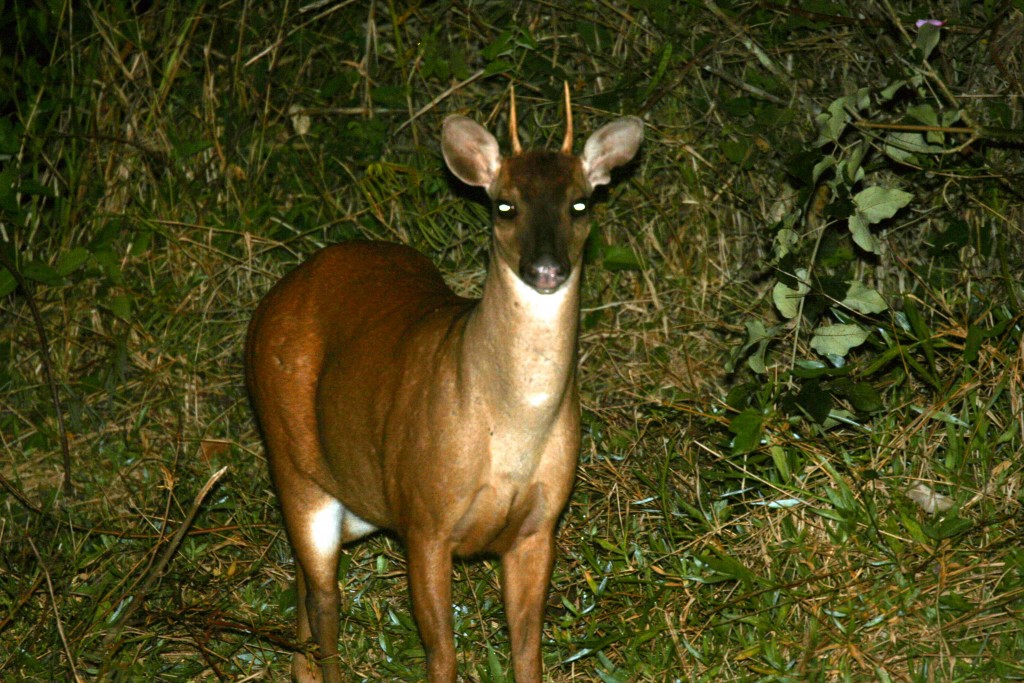
Red Brocket Deer, Mazama americana
The drive along the Transpantaneira was uneventful. We passed several groups of Marsh Deer and some spectacular Hyacinth Macaws, as well as small numbers of Capybara.
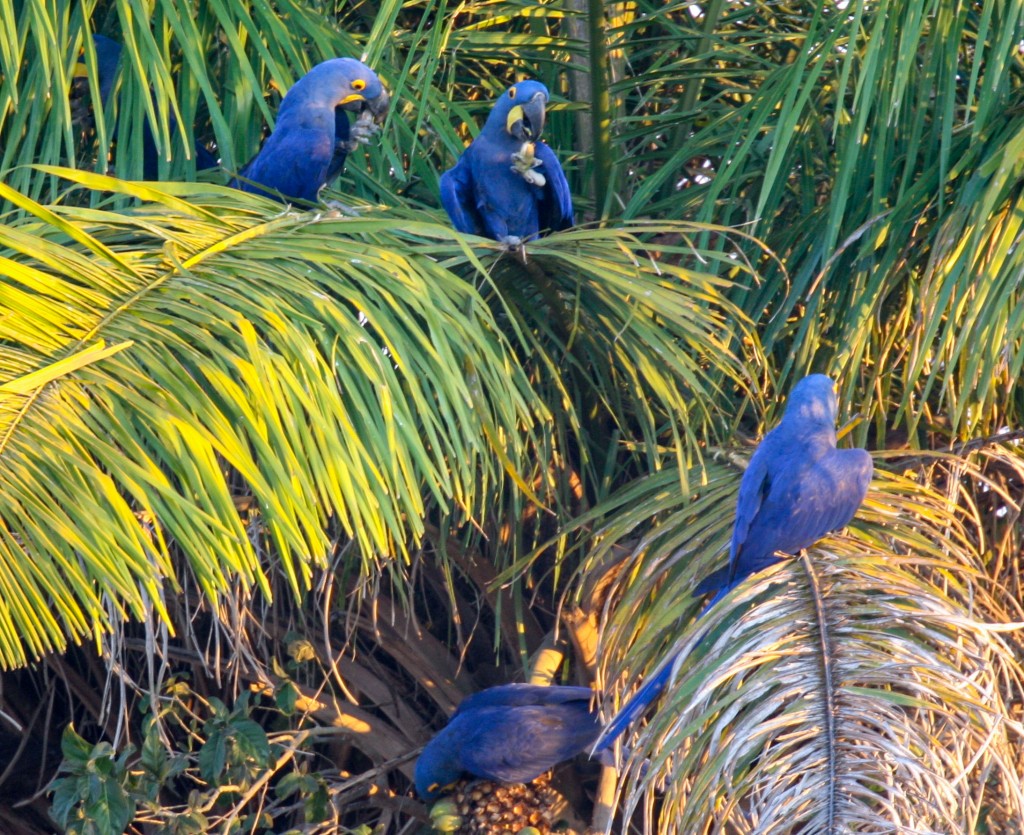
Hyacinth Macaws
As dusk fell I sat on the small deck overlooking the Rio Pixiam, sipping a capirioska, eating a bowl of Piranha soup, getting attacked by sandflies and spotlighting fishing bats swooping along the river. How very Brazilian. The various WildWings trip reports list the bats as Lesser and Greater Fishing Bats here depending on what year the report was written. Fishing bats have a distinctive colour and flight pattern but Greater Fishing Bats are twice the weight of the Lessers. The bats I saw along the river were Lessers: they were robust but not large enough to be the average 50g Greater Fishing Bats. But later in the evening a few much larger bats were swooping low along the patios of the hotel and these, I think, were probably Greater Fishing Bats.
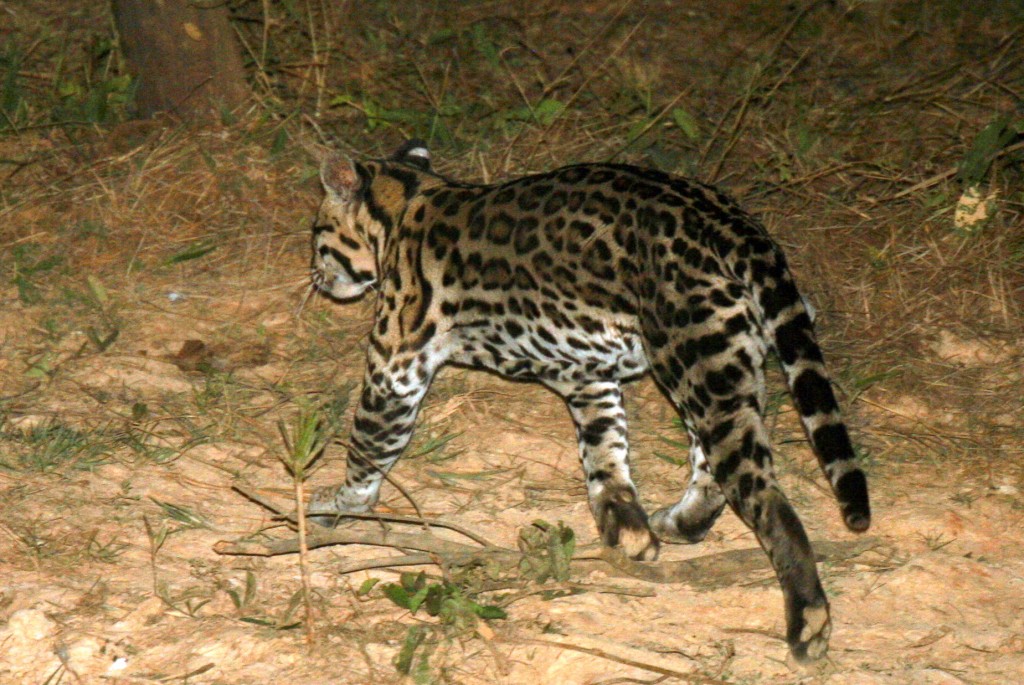
Ocelot, Felis pardalis
After dinner a strong southerly wind started which apparently didn’t bode well for spotlighting and it was certainly a lot quieter than the night before. We spent half an hour driving 5 km back up the road and saw just a couple of Crab-Eating Foxes and several groups of Capybara. On the way back we picked up a spectacular Ocelot, the species I had been hoping to see that evening. It seemed tempted to come closer in response to our squeaking but didn’t quite get up the enthusiasm.
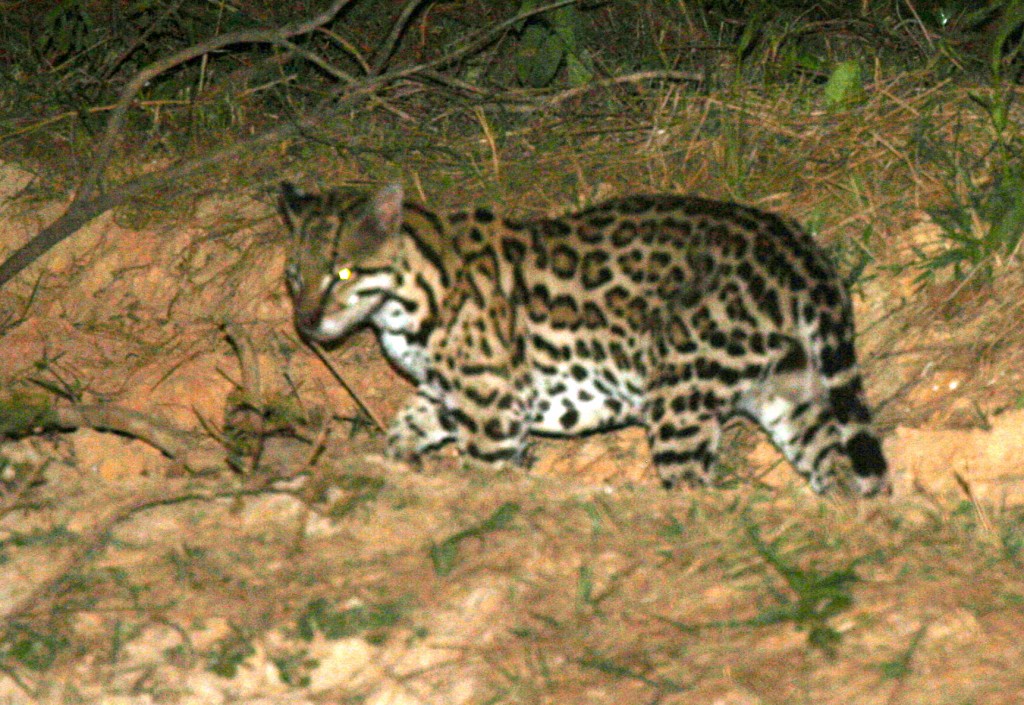
Ocelot, Felis pardalis
There was also another Southern Tamandua at the side of the road which didn’t stick around for long.
Day 6
An hour’s walk along the road near the hotel at 06.00 was mammal free. After breakfast we walked along the hotel’s trail that runs alongside the river and saw a small group of Black Howlers and two groups of Hooded (Azara’s) Capuchins as well as another Neotropical River Otter. But no Coatis which are often seen here. The weather was much cooler than the day before so at 10 a.m. it seemed worth spending another hour looking for stuff so we drove a few kilometres further south. Apart from Capybara and a single Marsh Deer we didn’t see any more mammals.
We set off again at 16.00 to drive the 50km to Pousada Jaguar. About 10km down the road we saw a group of Pantanal Marmosets getting stuck into a wasps’ nest in a dead tree and for once they were easy to photograph.
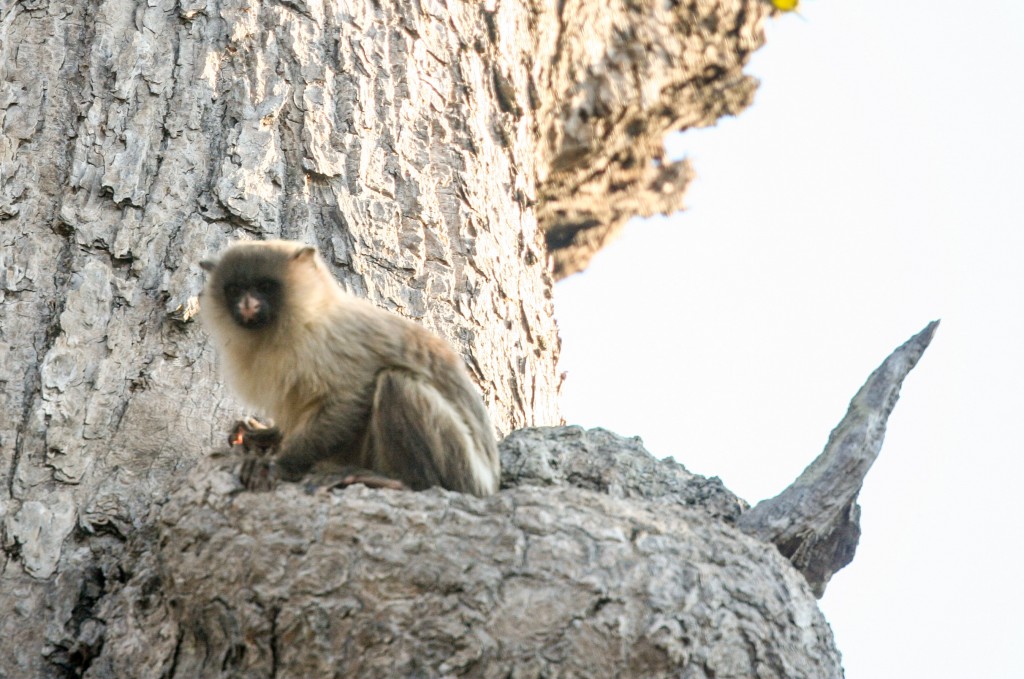
Black-tailed (Pantanal) Marmoset, Callithrix melanura
At 17.00, about 25km south of Pixiam, I saw my first South American Coati in some scrub just off the road. There were more capuchins a bit further on, along with more Marsh Deer and Capybara later. I arrived at the very nice Pousada Jaguar a little after dark.
At 20.30 we set out for a spotlight drive and less than a kilometre south of the pousada saw a smallish cat on the road. Eduardo turned off the light in the hope it would come closer but frustratingly it moved into the bushes off the roadside where we could hear but not see it. From the size and eyeshine (which was probably not as bright as the Ocelot we had seen the day before) Eduardo was convinced it was a Margay, and the tracks we saw the next day apparently confirmed it. But I didn’t quite share his conviction, knowing how hard these species can be to separate without a decent look. The highlights of the next two hours up and down the Santa Isabel road were two Tapir, one right at the side of the road, although neither stuck around for long. We also saw a Brazilian Rabbit and Red Brocket Deer. A Crab-Eating Fox was hanging around behind the pousada feeding on kitchen scraps but the Nine-banded Armadillo that was an occasional visitor had not been seen for a while.
Day 7
I walked along the road at dawn and saw more Hooded (Azara’s) Capuchins and Black Howlers. At 7.30 we were on the road, with boat in tow, heading for Porto Jofre, the end of the Transpantaneira and hopefully Jaguars. We arrived at the boat launch just before 9 a.m. and saw the first Azara’s Agouti of the trip.
Jaguars had been seen the previous afternoon so I was optimistic for our chances as we set off down the Cuiaba River in search of them. By 13.00 we had seen several groups of capuchins and howlers as well as many Capybaras (one was lying on a sandbank doing a passable imitation of a Jaguar which caused some excitement for a minute). But no cats.
We stopped for lunch and a siesta at a new safari-style camp which had just opened on the banks of the River Cuiaba. The accommodation was tented based around a large river boat that was the kitchen and dining room etc. The camp was monitoring Jaguar movements and several boats went out spotting each day, equipped with radios to report back to base.
The siesta over, we set off back towards Porto Jofre at 15.00. By 17.15 we had seen two groups of at least five Giant Otters (one just downstream of the Rio Piquiri confluence and another on the Rio Piquiri itself).
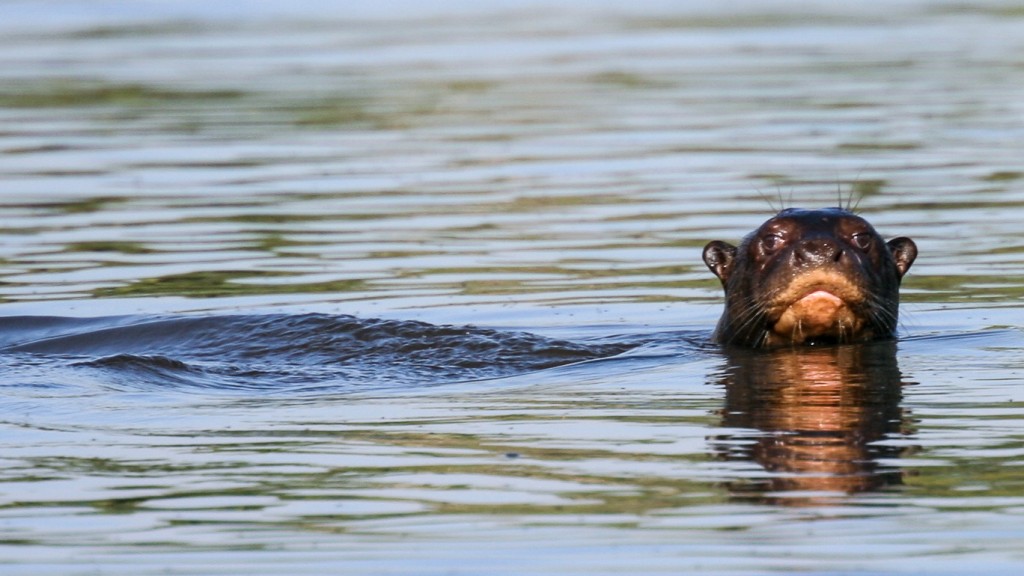
Giant Otter, Pteronura brasiliensis
A boat from the campsite said one of their spotter boats had seen two Jaguars at 16.00 downstream, just a few minutes before we had passed the same spot but they hadn’t stuck around. So, as we headed back to Cuiaba in fading light, I had resigned myself to a Jaguar-free day.
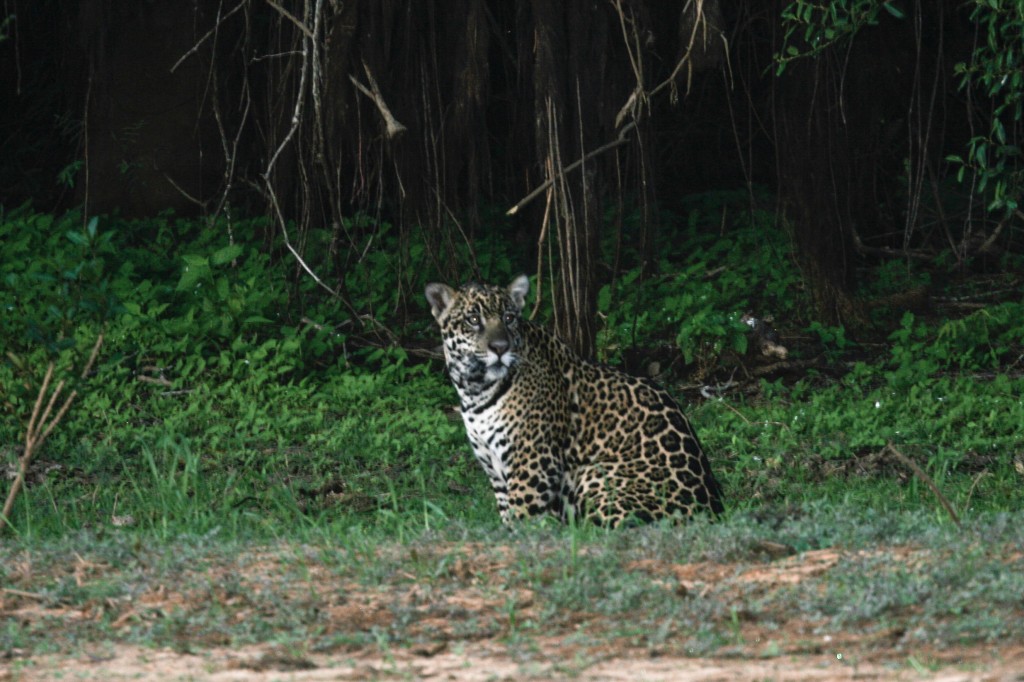
Jaguar, Panthera onca
But it’s always darkest before the end of the boat trip and it was then that Eduardo shouted Jaguars, pointing towards two of the most beautiful animals I have ever seen lounging on the river bank.
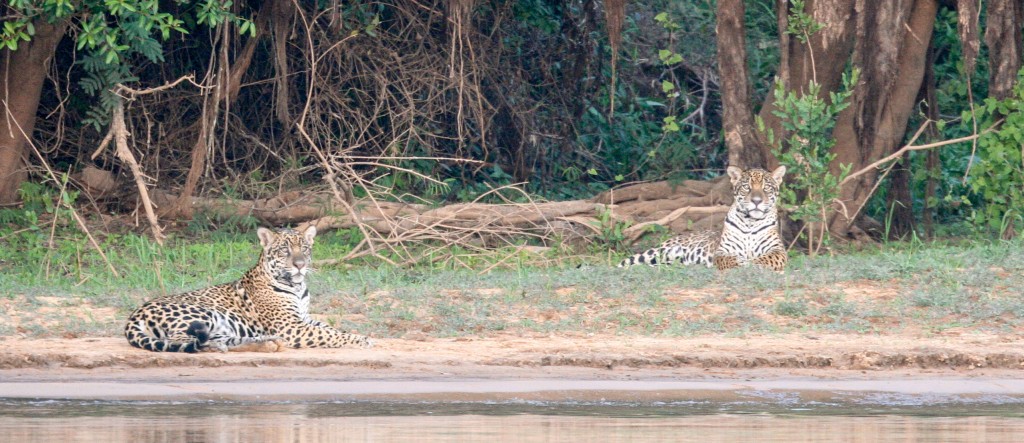
Jaguars, Panthera onca
As we approached the male trotted away but the female watched us with regal disinterest as we got within 30 metres. The male returned five minutes later. I was spellbound for the next 15 minutes.
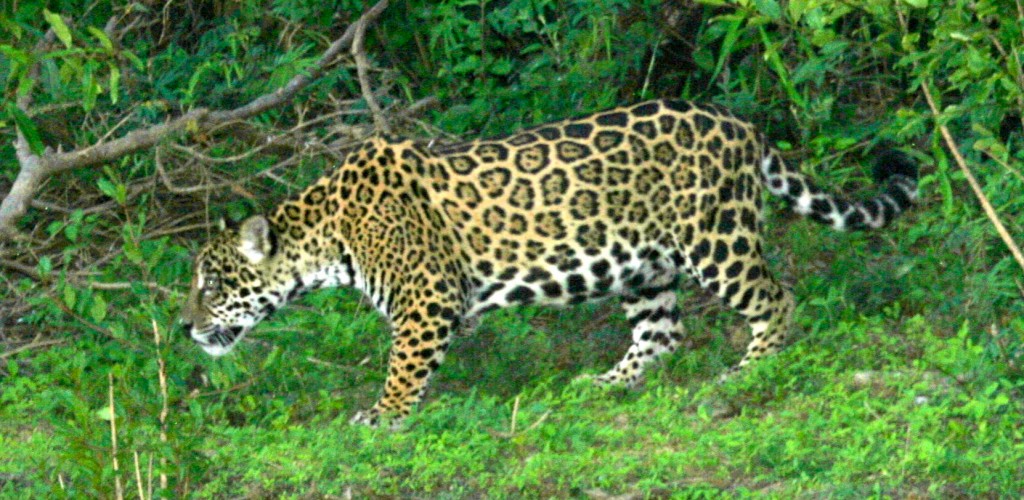
Jaguar, Panthera onca
Clouds of bats were feeding high over the river just before sunset, while both Lesser and Greater Fishing Bats were skimming the surface. I had great views of the larger species back at the boat launch and there was still enough light to see its huge feet trailing behind it.
We drove the 35 km back to the pousada with the spotlight on. The only mammal of note was a brief look at an Ocelot about 5km north of Porto Jofre. A couple of feral Buffalo on the road were tricky to overtake.
After dinner I headed out to the forest behind the pousada to try for armadillo. A couple of Red Brocket deer were grazing in the paddock behind the house. The forest was quiet but on the way back there was an armadillo-like rustling in the leaves and after a patient 20 minutes of walking up and down the track trying to follow the animal’s apparently aimless wandering through the scrub I was delighted to see a Nine-Banded Armadillo emerge from the bushes at my feet.
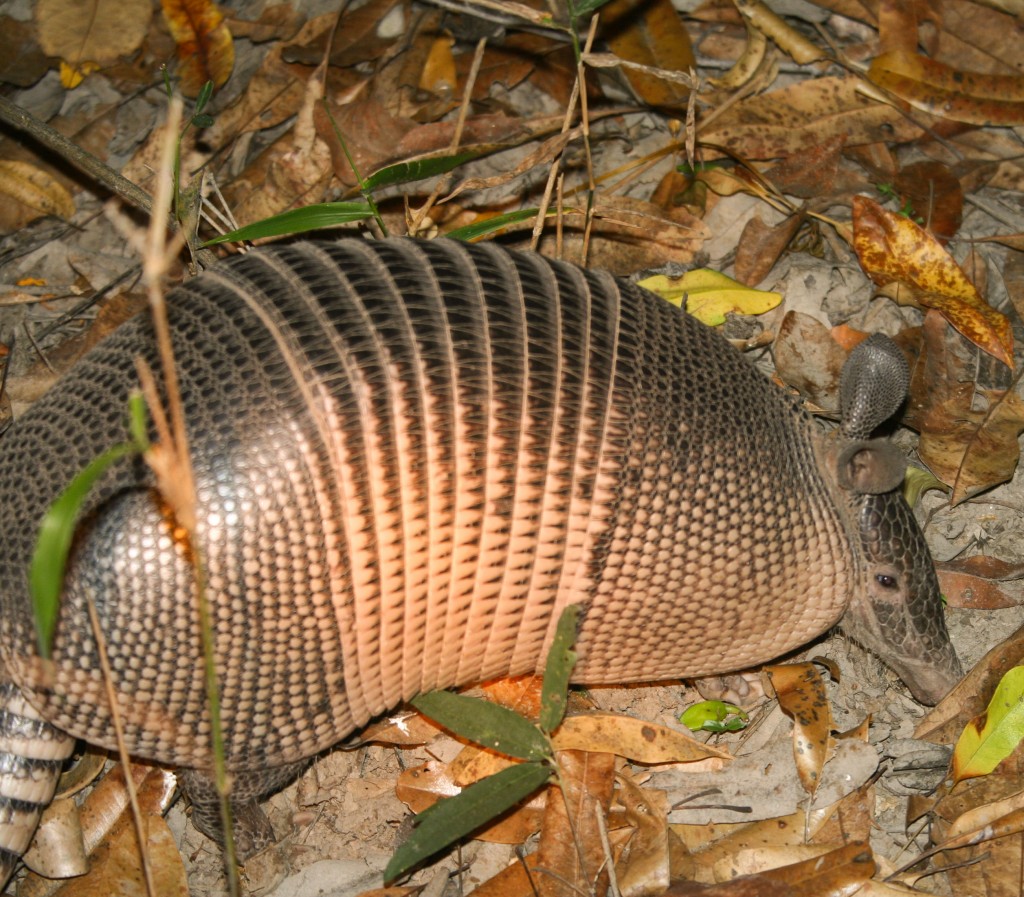
Nine-banded Armadillo, Dasypus novemcinctus
The beast was apparently oblivious to me and my spotlight. Its rustling had quite a distinctive rhythm with a sort of rustle-rustle-pause-pause-pause kind of a beat. I had spent many hours looking for armadillos in Texas and so this was a particularly pleasing end to the day.
Day 8
The next day before breakfast I walked from the pousada to the abandoned research station on the Santa Isabel Road. More capuchins, howlers and Capybaras but no other mammals, though I heard but didn’t see some bats scuttling around in the roof of one of the station buildings.
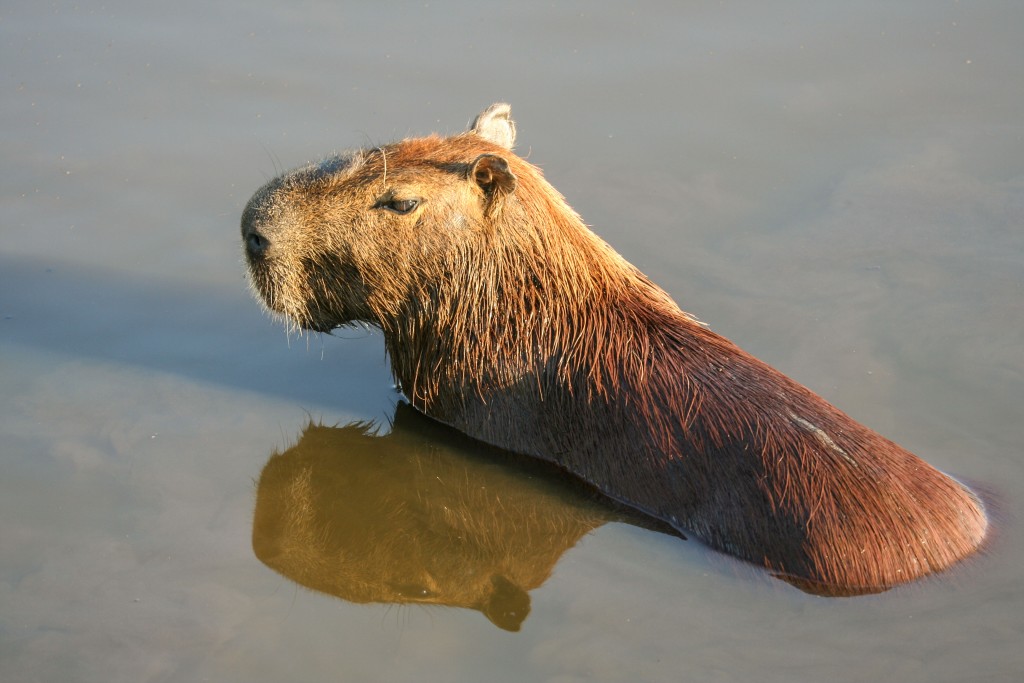
Capybara, Hydrochoerus hydrochaeris
After brekky Eduardo took me back through the forest behind his place. Capuchins, howlers and Azara’s Agoutis were the only mammals. An afternoon drive along the Santa Isabel Road in search of Jaguarundis and White-Lipped Peccaries didn’t find either species but we did see another agouti, more howlers and capuchins. After dark a Forest Rabbit crossed the road shortly followed by a Coati caught in the spotlight.
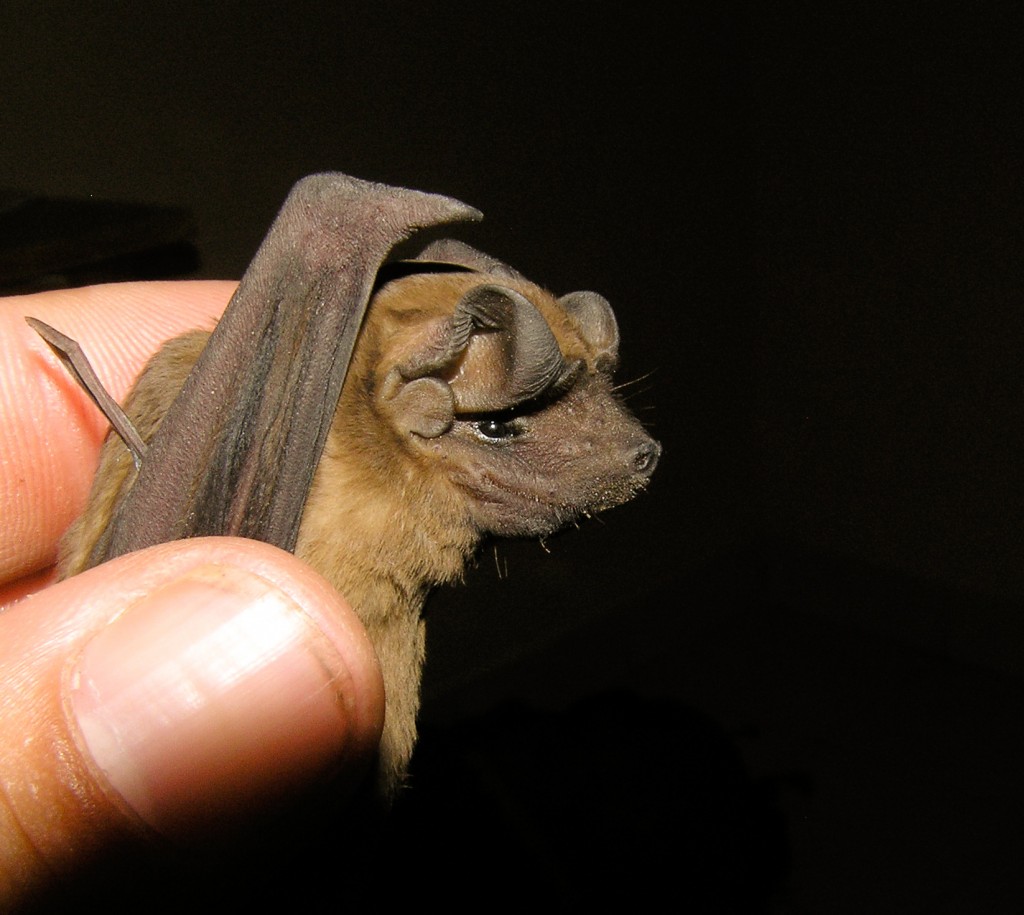
Pallas’s Mastiff Bat, Mollusus mollusus
There were Pallas’s Mastiff Bats (Mollusus mollusus) roosting in the roof of the pousada as well as a gorgeous Inca Broad-Nosed Bat (Platyrrhinus incarum) in the garden (now split from Platyrrhinus helleri).
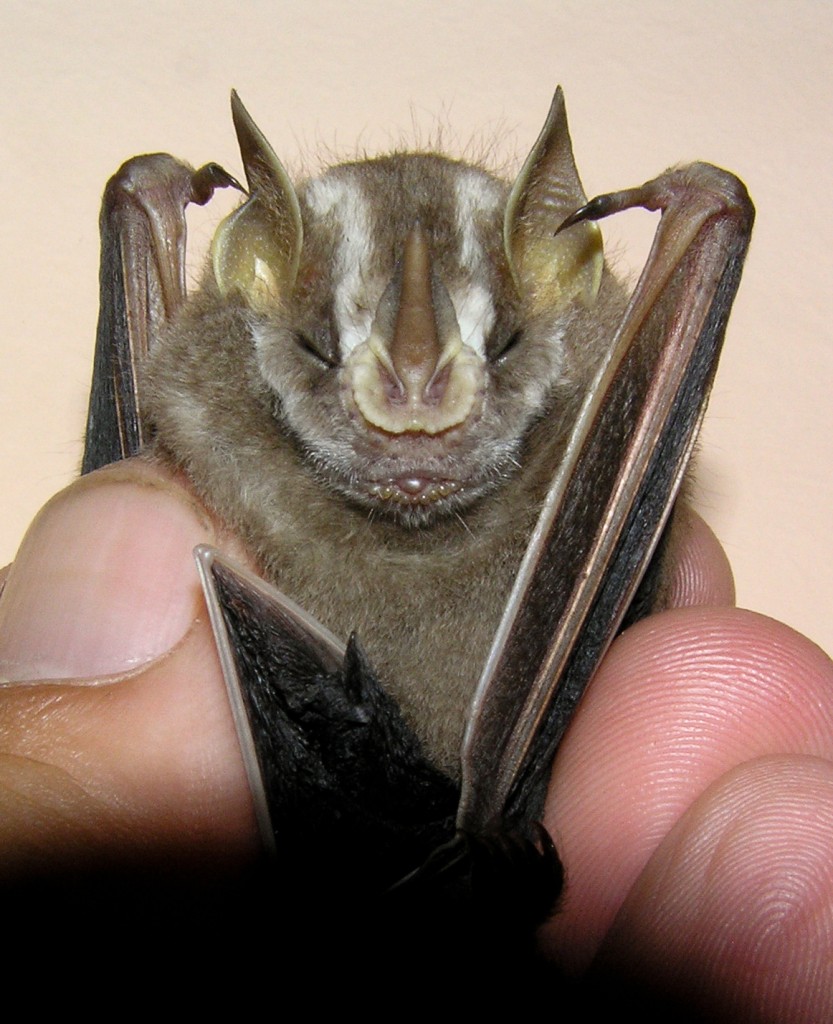
Inca Broad-nosed Bat, Platyrrhinus incarum
During a 2.5 hour night drive after dinner along the Santa Isabel Road we saw three Tapirs (a mother and juvenile about 4km down the Santa Isabel at 22.00, and a lone juvenile feeding near the research centre at 22.30), a couple of Red and Grey Brocket Deer, a fleeting Giant Anteater and a mouse.
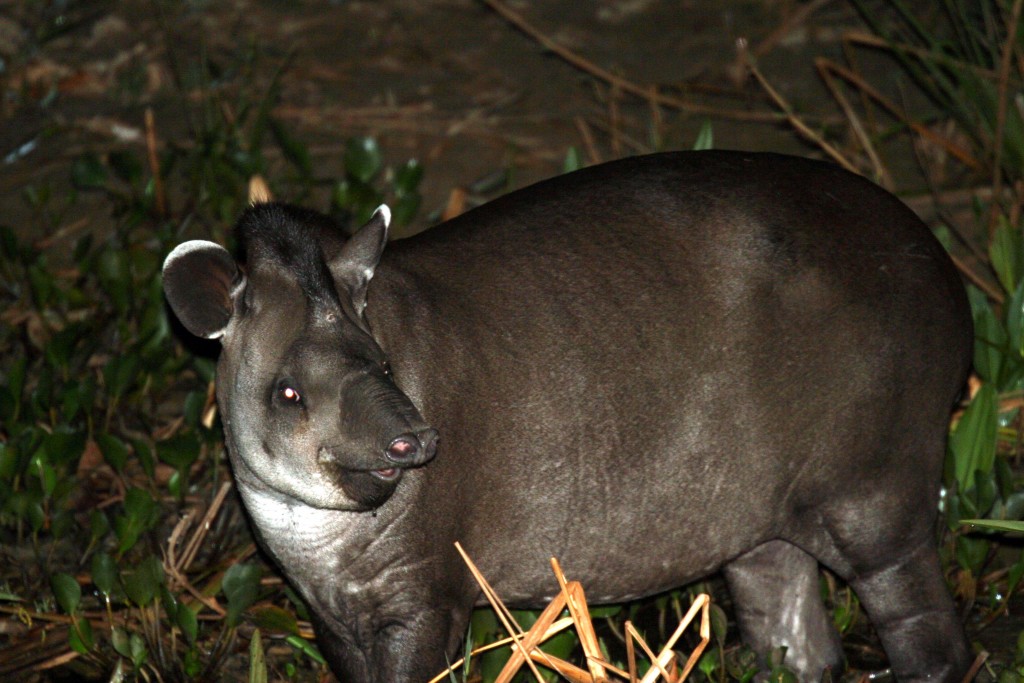
Brazilian Tapir, Tapirus terrestris
Day 9
We left early the next morning for the three hour drive north to Araras Lodge. The only mammal of note was a superb Marsh Deer stag.
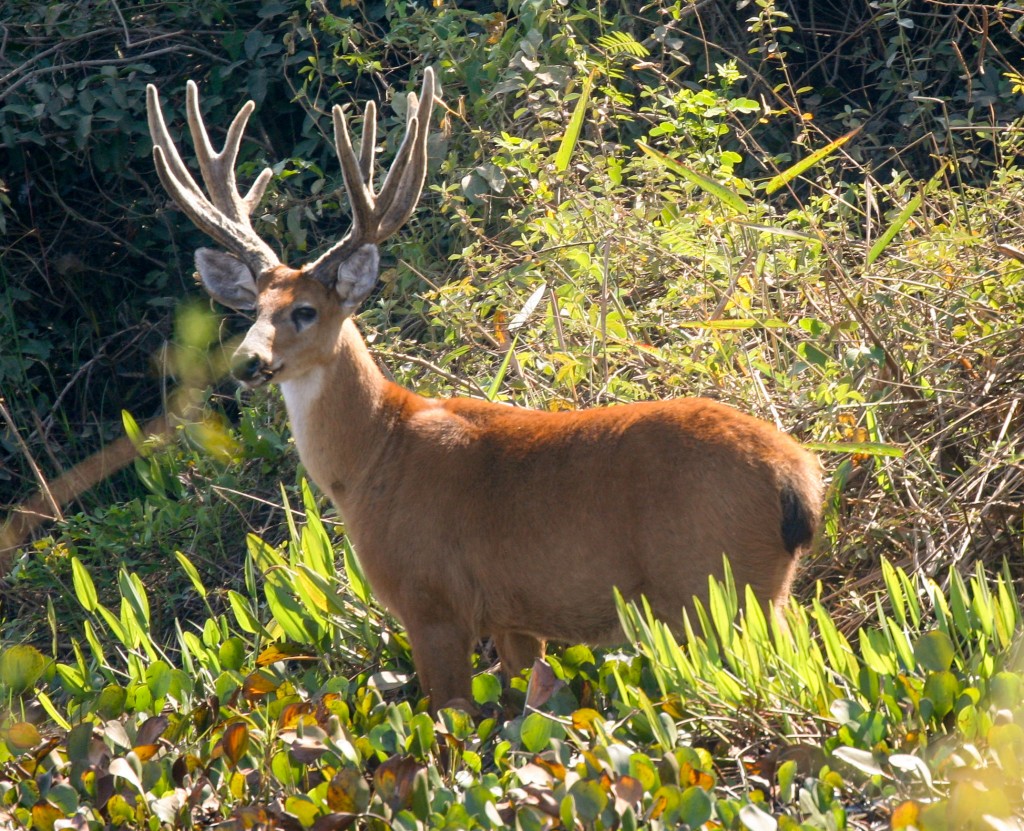
Marsh Deer, Blastocerus dichotomus
Araras is a luxury kind of a place. It is very nice, expensive, and it felt a bit like Disney World after the more rustic charms of the Pantanal further south. That said, I think Araras must be in the middle of a biodiversity hotspot because the diversity and abundance of mammals in the area around the lodge is incredible.
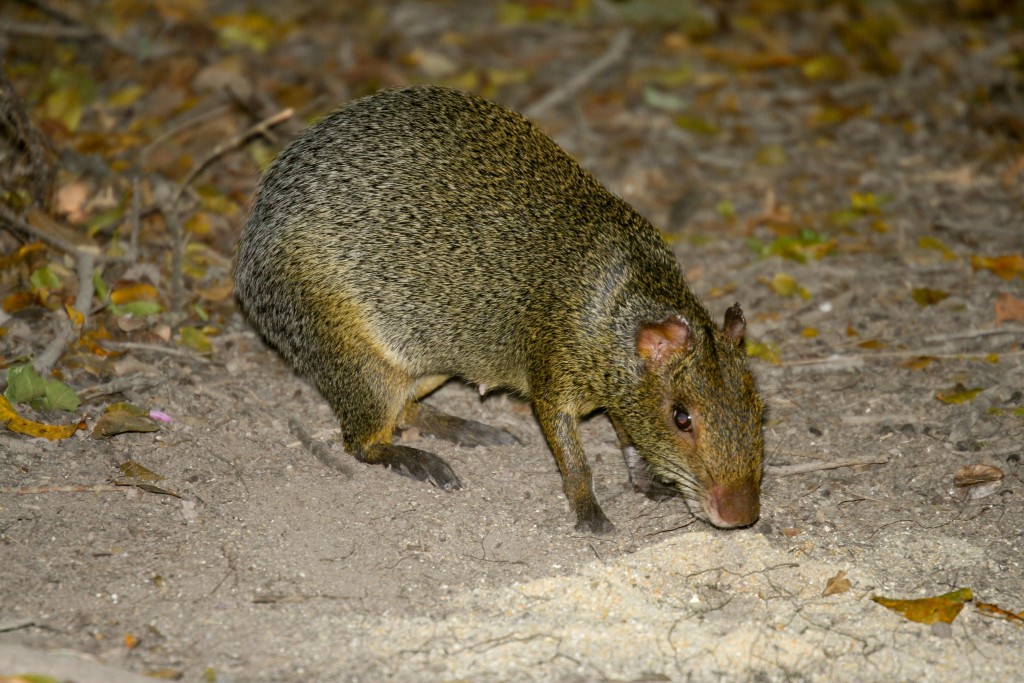
Azara’s Agouti, Dasyprocta azarai
A walk along the boardwalk in the late afternoon produced one Coati, several agoutis and capuchins and many Capybara.
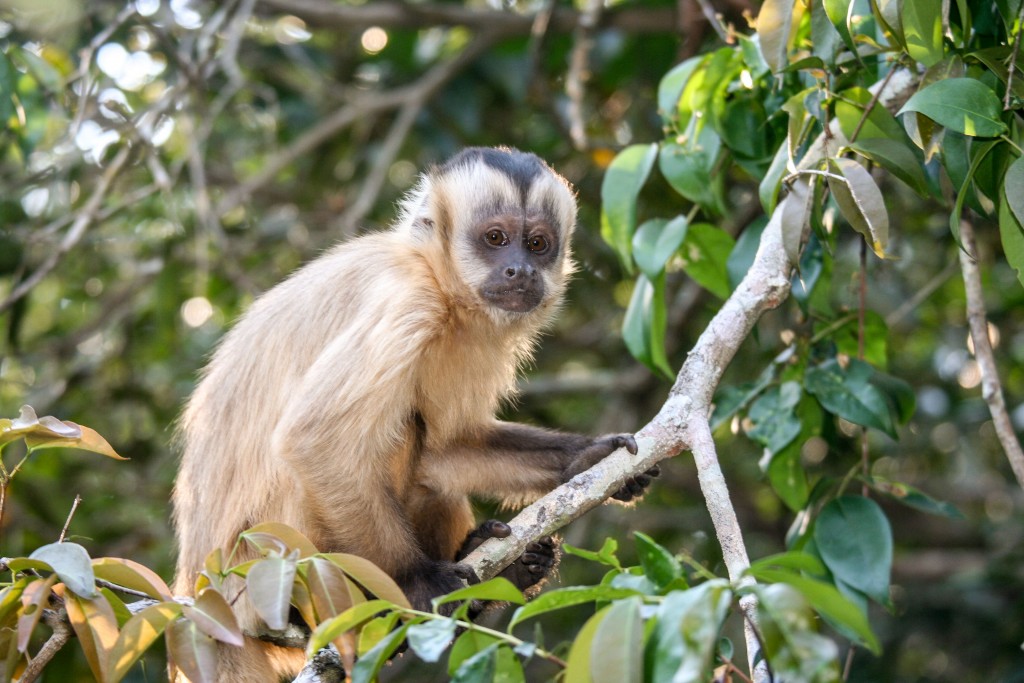
Hooded (Azara’s) Capuchin, Cebus cay
From the two lookout towers we could see plenty of Marsh Deer and feral Pigs moving around the wetlands. A Toco Toucan was feeding at the top of the other, smaller, lookout tower.
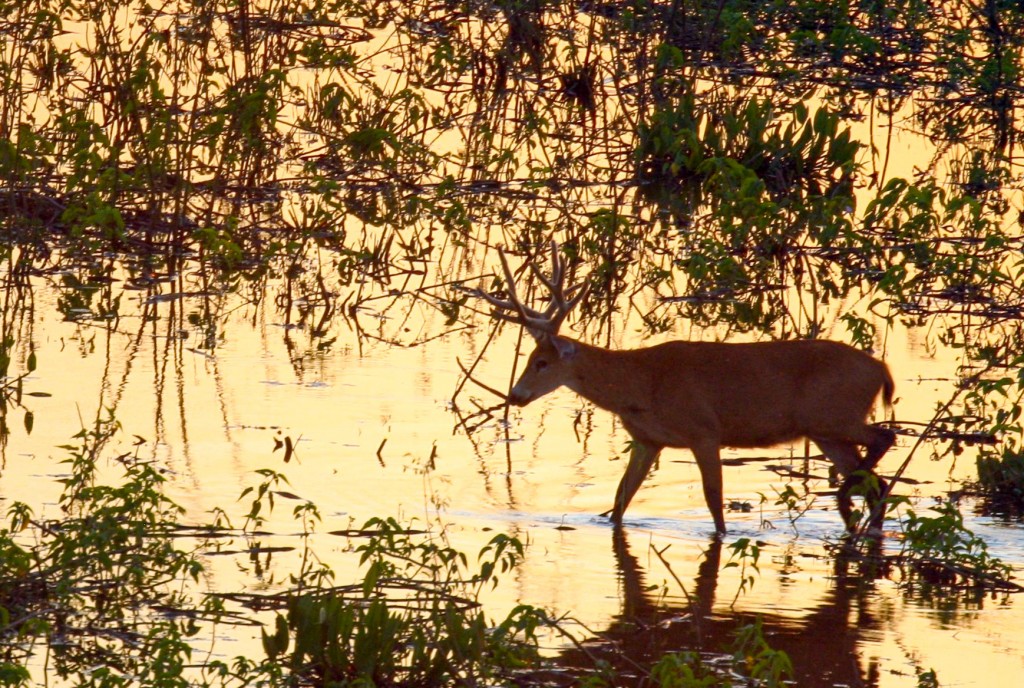
Marsh Deer, Blastocerus dichotomus, at sunset
The guys at the lodge wanted me to set up a mist night to try to catch some bats and after dinner we caught a couple of Flat-faced Fruit-eating Bats (Artibeus planirostris).
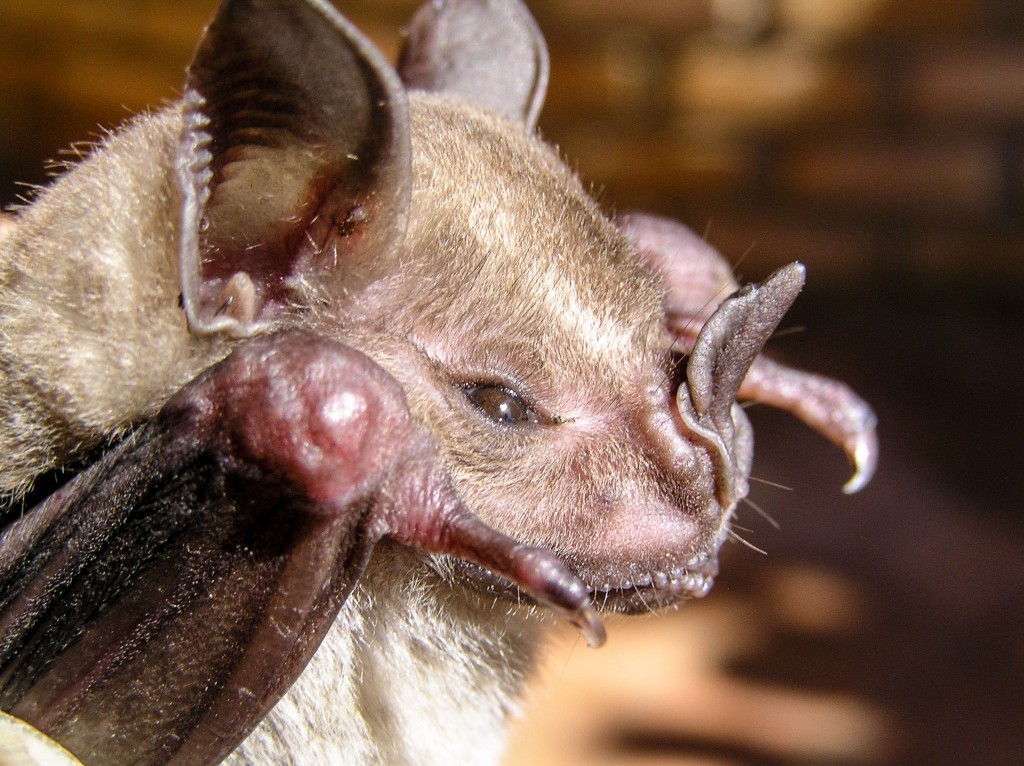
Flat-faced Fruit-eating Bats, Artibeus planirostris
At 20.00 we headed out for a night drive. The night was several degrees warmer than the past few evenings which may have helped the animals come out in force. We spent the first hour driving around the block of land across the highway from the lodge (the Passo Da Ema).
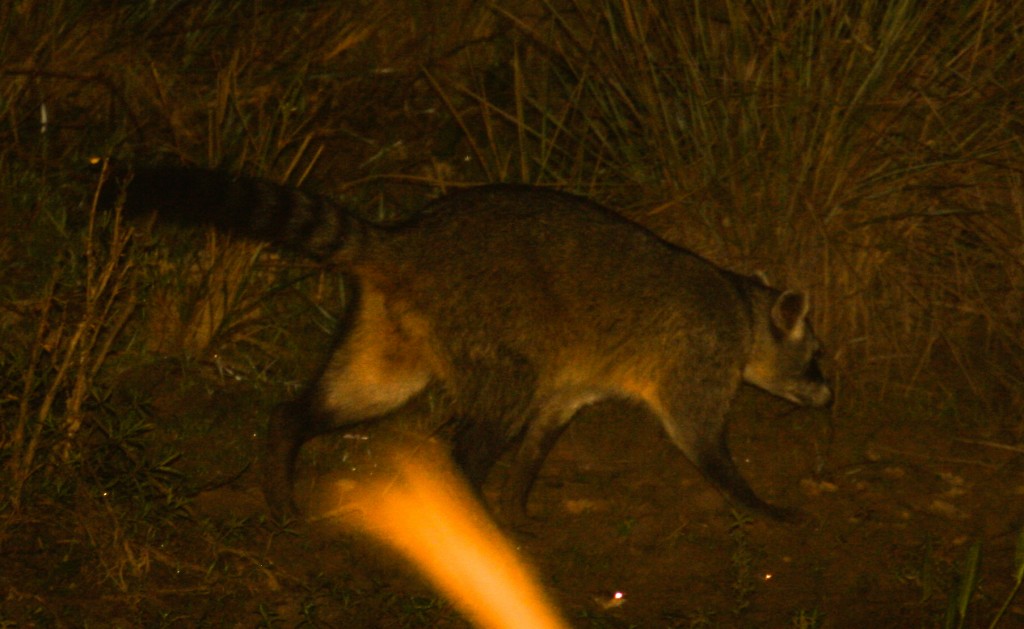
Crab-eating Raccoon, Procyon cancrivorus
A hundred metres down the road we saw a Common (Grey) Four-eyed Opossum in a tree, soon followed by the first of about ten Crab-eating Foxes and six Crab-eating Raccoons together with a few Red Brocket Deer. We also had the best views yet of a Giant Anteater.
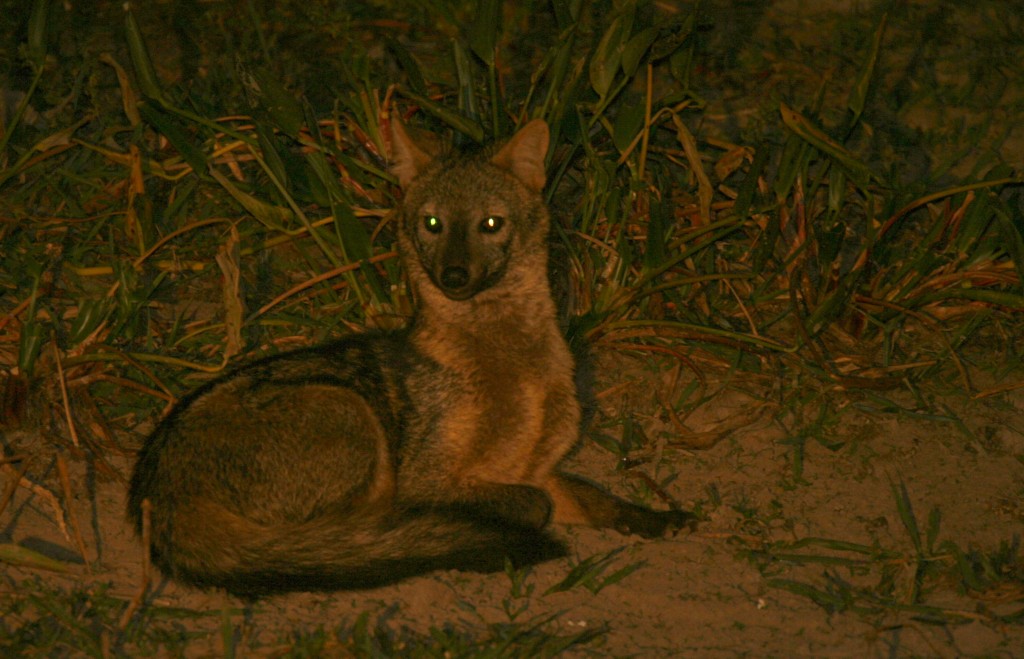
Crab-eating Fox, Cerdocyon thous
Back on the highway heading south we saw a Southern Tamandua wandering through a paddock and then climbing a tree, followed by a Tapir that for once was unconcerned by the light and hung around for at least five minutes. An outstanding night drive.
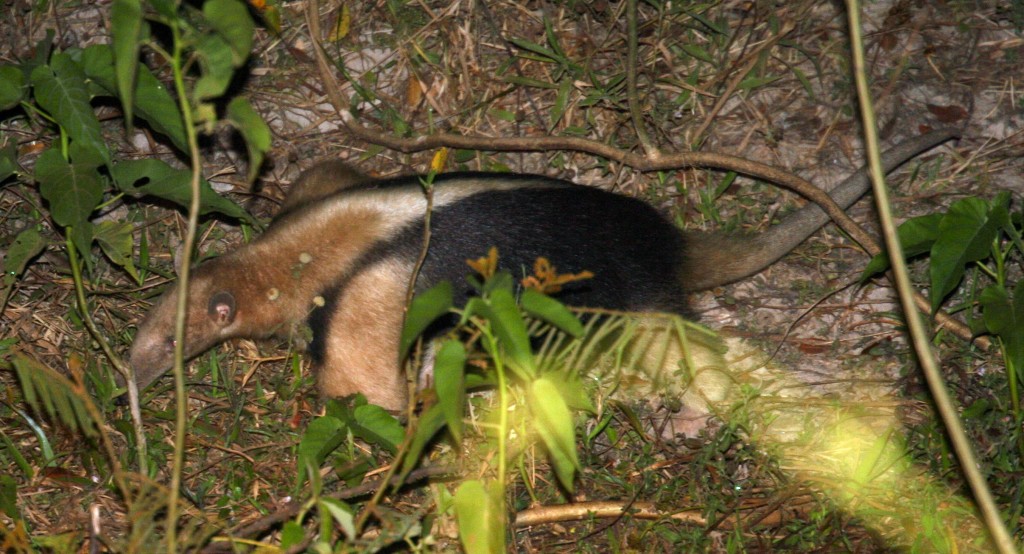
Southern Tamandua, Tamandua tetradactyla
I took a walk along the boardwalk at about midnight and saw two Nine-banded Armadillos in the space of 15 minutes.
Day 10
We visited the tower at 6 a.m. the next day but didn’t see a great deal and after breakfast headed back into the land across the highway from Araras. I’d been told Tayra were often seen in the forest here at Passo Da Ema. We saw a group of at least eight Coatis on the way in, but by 9 a.m. the temperature was already up in the mid 30s and the forest here was particularly dry and hot.
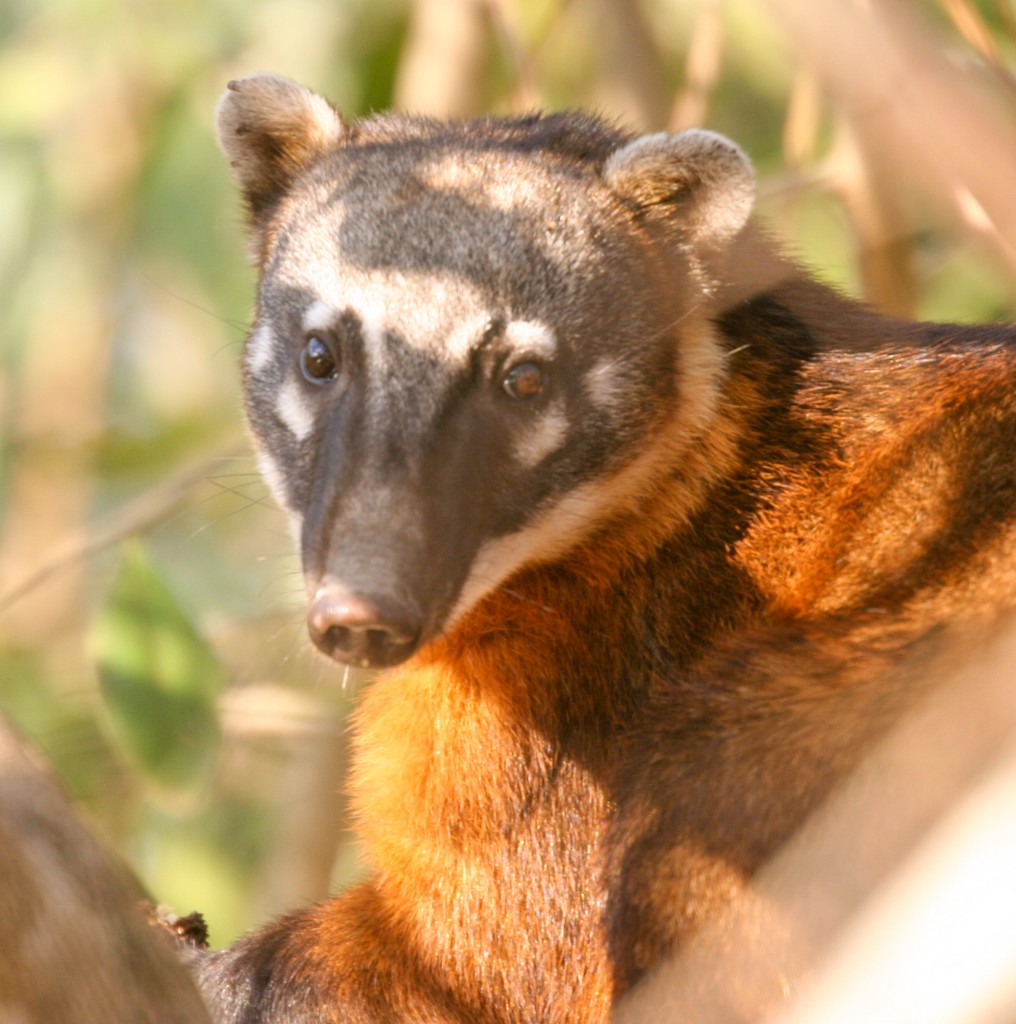
South American Coati, Nasua nasua
In the afternoon I walked the boardwalk again – a few Azara’s Agoutis, plus Marsh Deer and a feral Pig from the viewing platform were the only mammals. We went back to Passo Da Ema at about 5 p.m. to try again for Tayras. We saw another Coati, a Crab-eating Fox, a couple of agoutis and some Pantanal Marmosets.
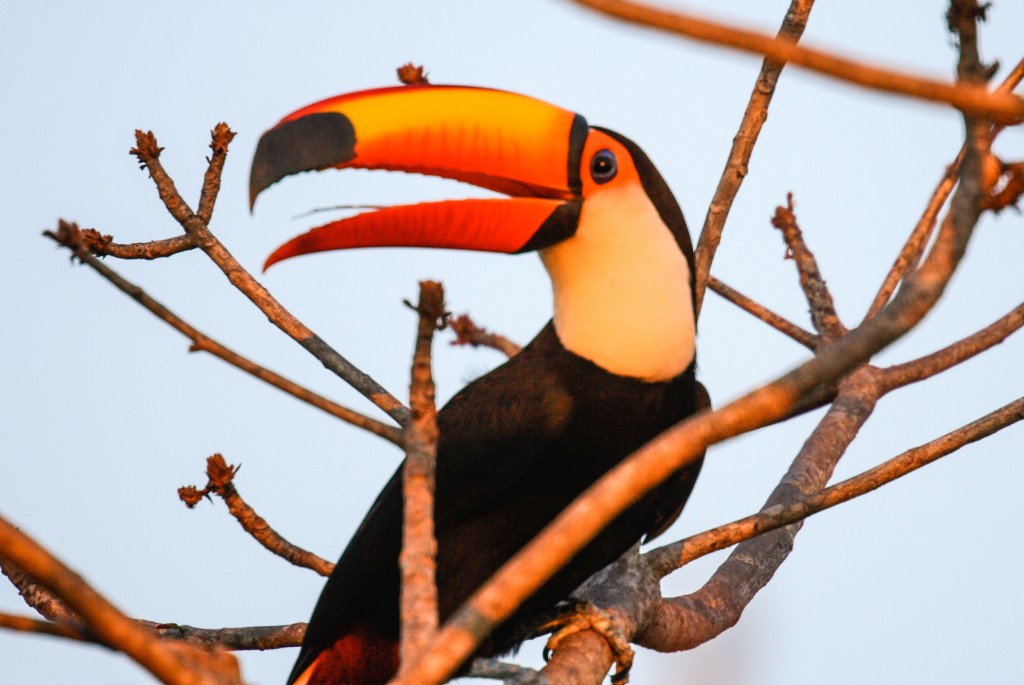
Toco Toucan
Our last spotlight drive in the Pantanal was quite quiet. Having said that I saw another tapir, another tamandua, a few Crab-eating Foxes and Crab-eating Raccoons plus presumably the same Common (Grey) Four-Eyed Opossum as the night before (this time out of the previous night’s fig tree and in the vine tangle next door). A short spotlighting walk along the boardwalk at 23.00 and another at 05.00 were largely mammal-less.
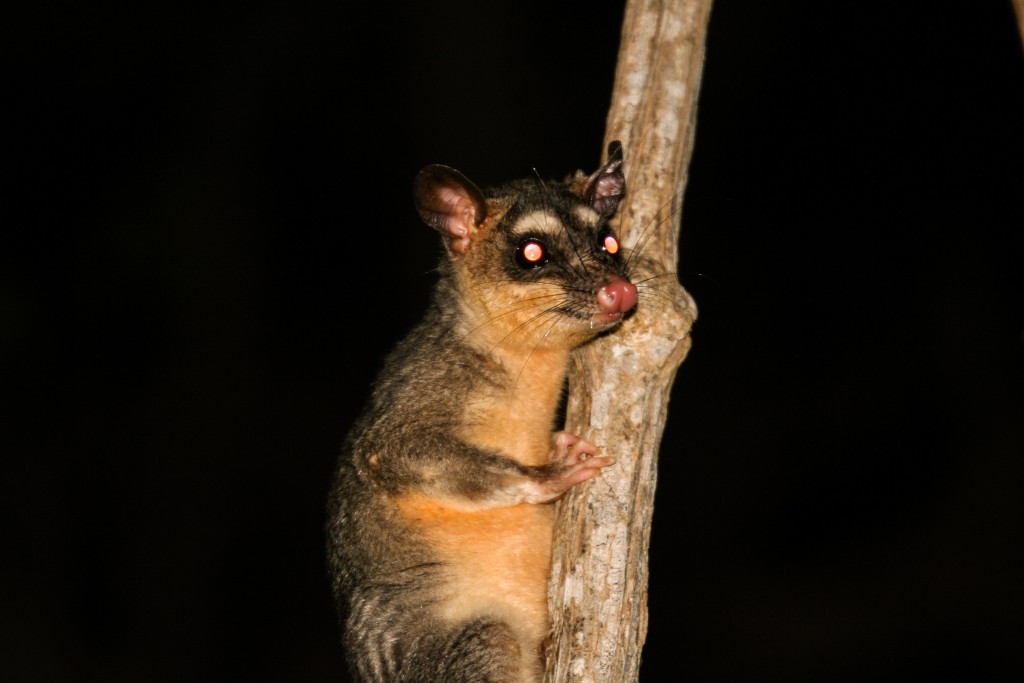
Common (Grey) Four-eyed Opossum, Philander canus
Stuff I Missed
Not a lot is the answer (for once). Judging by the various WildWings trip reports I saw pretty much everything that I expected plus a couple of slightly less commonly spotted things including the Grey Four-Eyed Opossum and armadillos. There was some chance of seeing a Jaguarundi, Margay, Oncilla or even a Puma around Pousada Jaguar but they were all long shots. Tayras and White-lipped Peccaries are also both seen occasionally but neither are common, though the peccaries are easier to see at other times of year apparently.
Minais Gerais And Espirito Santo
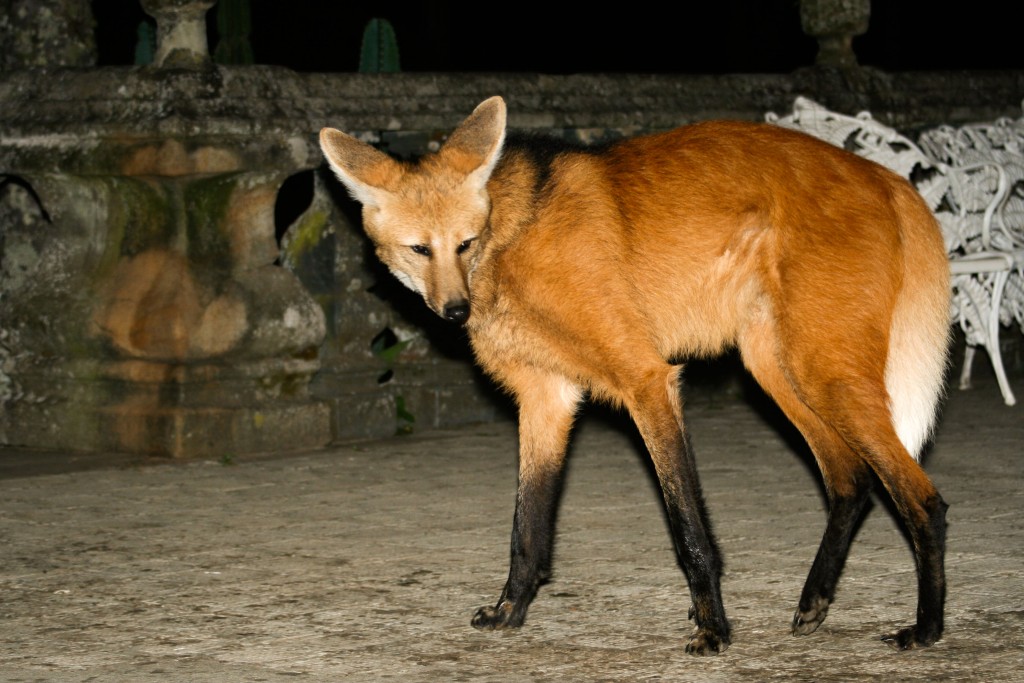
Maned Wolf, Chrysocyon brachyurus
Day 11
I left Araras at 07.00, was back in Cuiaba at 09.30, on a plane to Sao Paulo at 11.00 and then on another to Belo Horizonte at 16.00. Regina Ribeiro, who was to be my guide, had hurt her back so she arranged for a friend of hers – Marclei – to accompany me for the first leg of the trip. He met me at the airport and we drove the four hours to the small town of Sao Roque de Minas, via a very cheap and excellent all you can eat barbeque restaurant. I got a glimpse of what was probably a fox at the side of the road not far from Sao Roque at about 23.00.
Canastra National Park
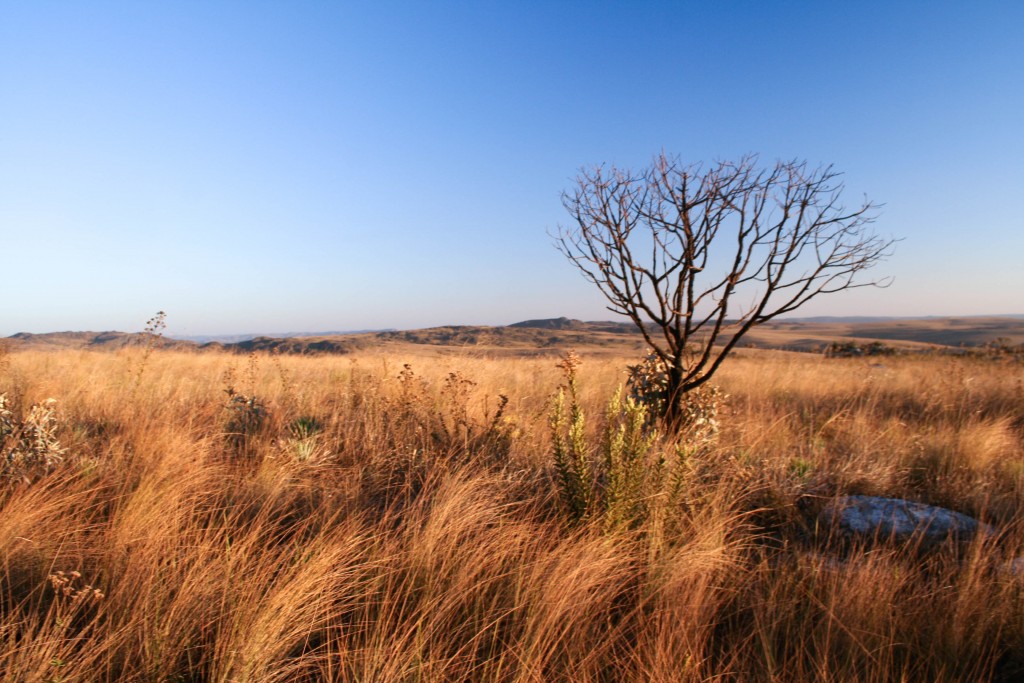
Canastra National Park
Day 12
Regina had arranged for a local guide – Toninho – to meet me at the Pousada Barcelos hotel the next day. At 07.00 we were on our way up to Canastra National Park. The park officially opens at 08.00 but this is Brazil and the park staff were mates with Toni, so they were happy for us to go in early. The park is beautiful highland cerrado grassland.
At most places along the road it’s possible to for see several kilometres in every direction. But the park is huge and the Maned Wolf density is low. By 08.30 Toni had spotted one and we got a long – if distant look – at a wolf wandering through the grassland near an old stone-walled cattle corral that is signposted as a tourist site (about 10km along the park road I guess). We tried to approach the wolf on foot, but it wandered below a rise and we lost it.
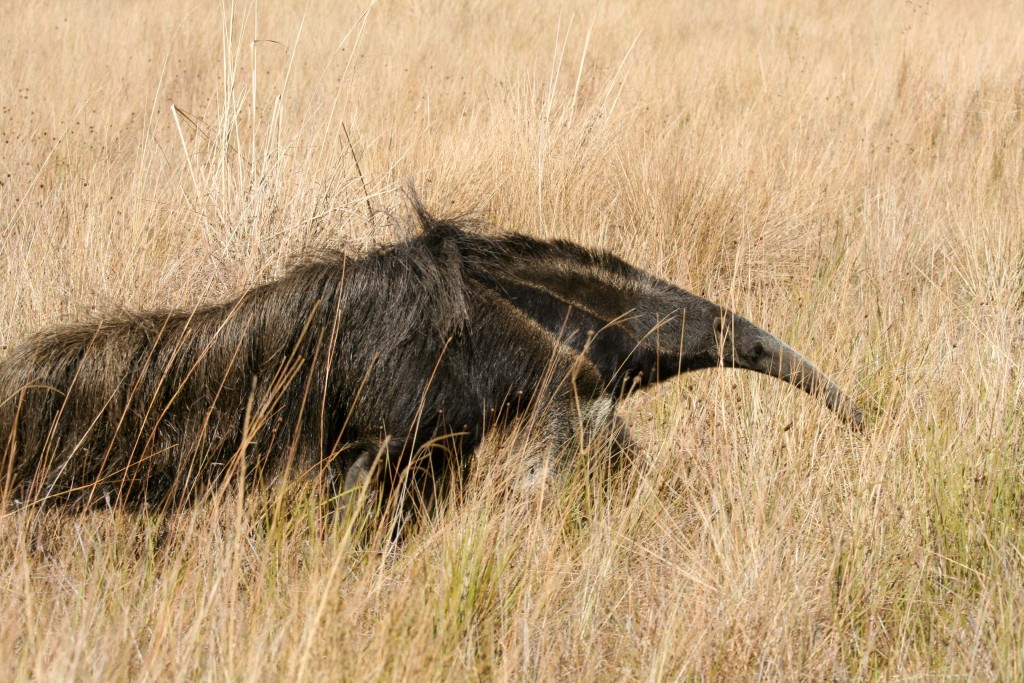
Giant Anteater, Myrmecophaga tridactyla
Pampas Deer tend to hang out further into the park and it wasn’t until midday that we – well Toni, the man has eyes like a hawk – saw one (not far off the side of the road but well camouflaged none the less). I was able to get quite close to it.
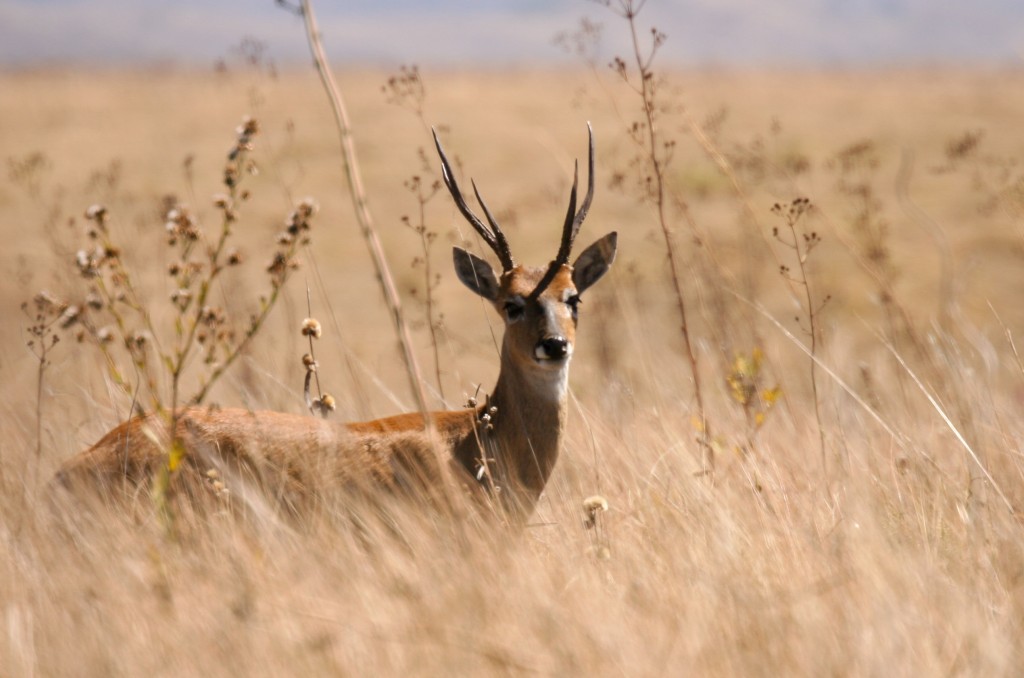
Pampas Deer, Ozotoceros bezoarticus
After a siesta on some rocks overlooking a waterfall I turned my attention to getting some better Giant Anteater photos. Canastra is swarming with Giant Anteaters and it’s pretty easy to walk to within touching distance of them if you’re quiet and stay down wind.
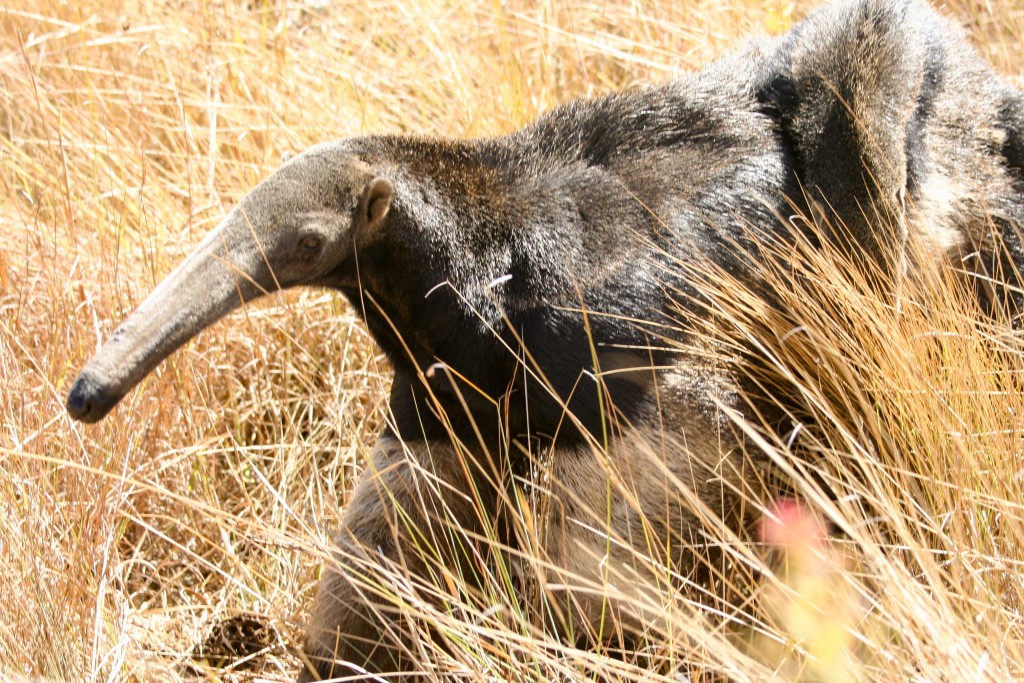
Giant Anteater, Myrmecophaga tridactyla, carrying a baby
We saw at least 10 during the day – the first was at 10.00 and the last at 18.00 as we left the park.
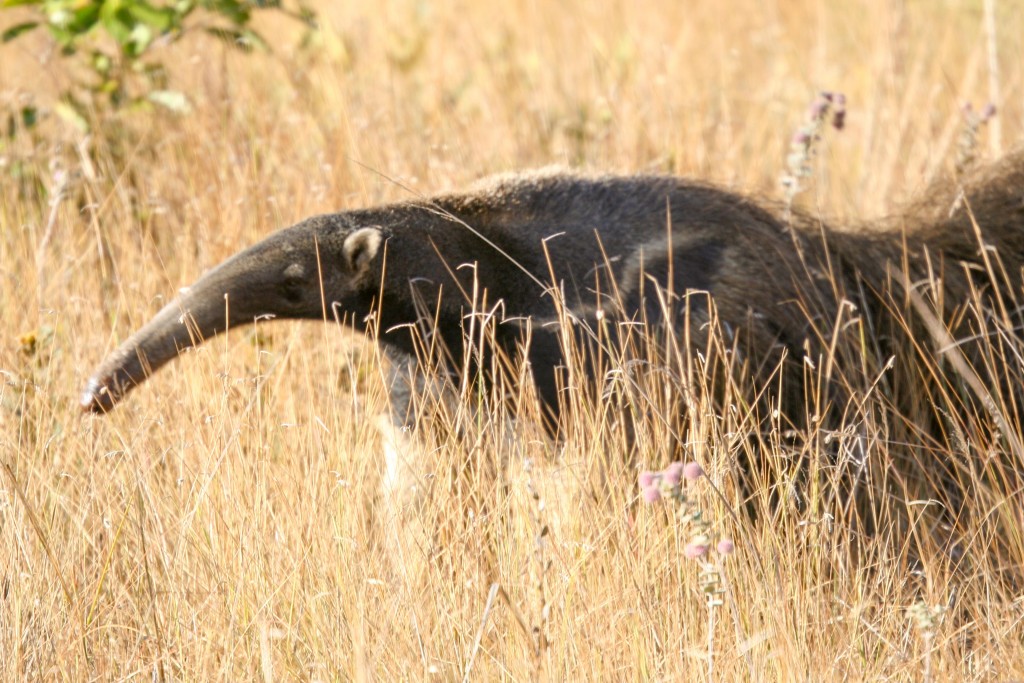
Giant Anteater, Myrmecophaga tridactyla
At about 17.00 Toni spotted another wolf a couple of kilometres back from where we’d seen the one in the morning. It was far away and didn’t hang around for long.
Back in town we visited the Hotel Chapadão da Canastra to check that it would be OK to look for Marmosets there the next day. The photos the friendly owner had taken of a Giant Armadillo in Canastra were sheer torment. One amazing beast. They aren’t common there though – she had only seen one in her 35 years in the area. Toni reckoned some of the coffee plantations around town were better places to look for some of the six species of armadillos found in the area.
Day 13
After breakfast I headed back to the Hotel Chapadão da Canastra where Black-Tufted Marmosets are supposedly easy to see in the back garden.
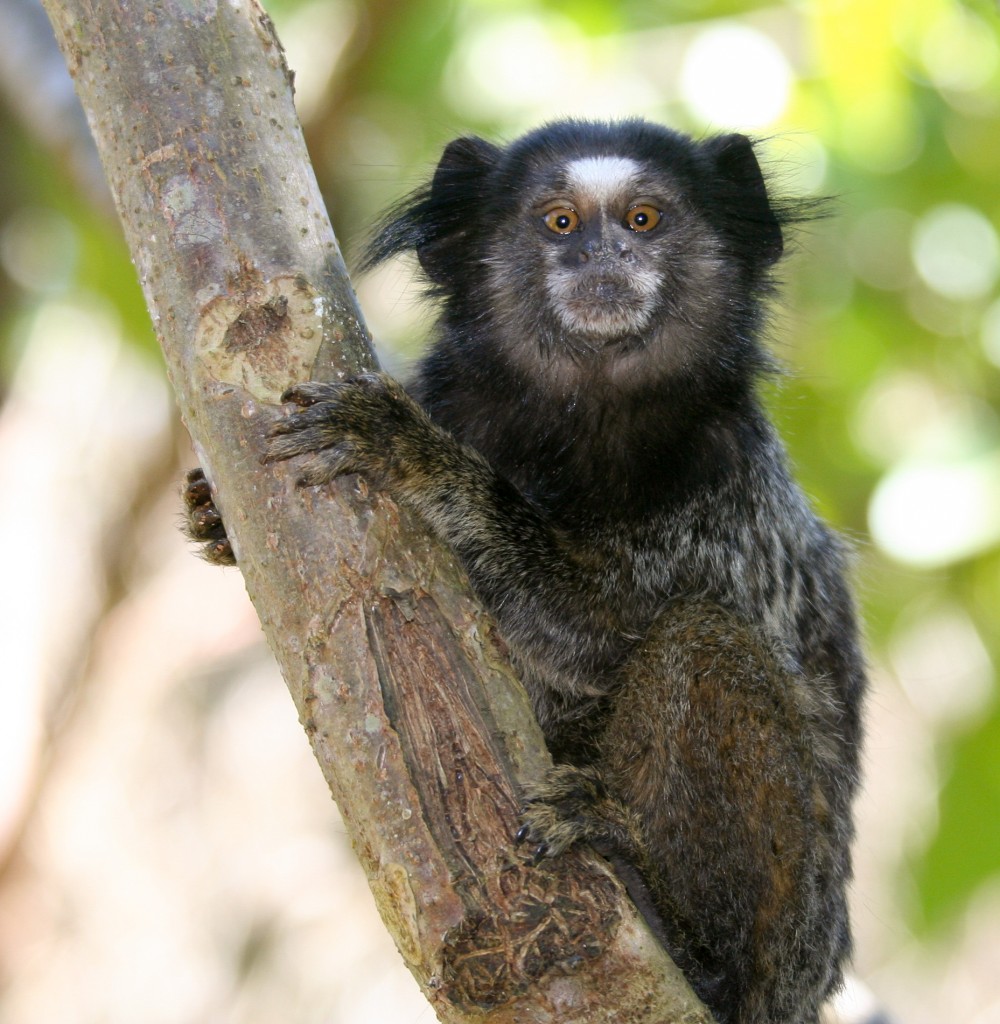
Black-tufted Marmoset, Callithrix penicillata
It took two hours for the monkeys to arrive (it was a fairly cool morning and they might have been having a lie in) but 20 or so came down from the gallery forest to the back garden to feed on bananas, and many took food from the hand.
Caraca
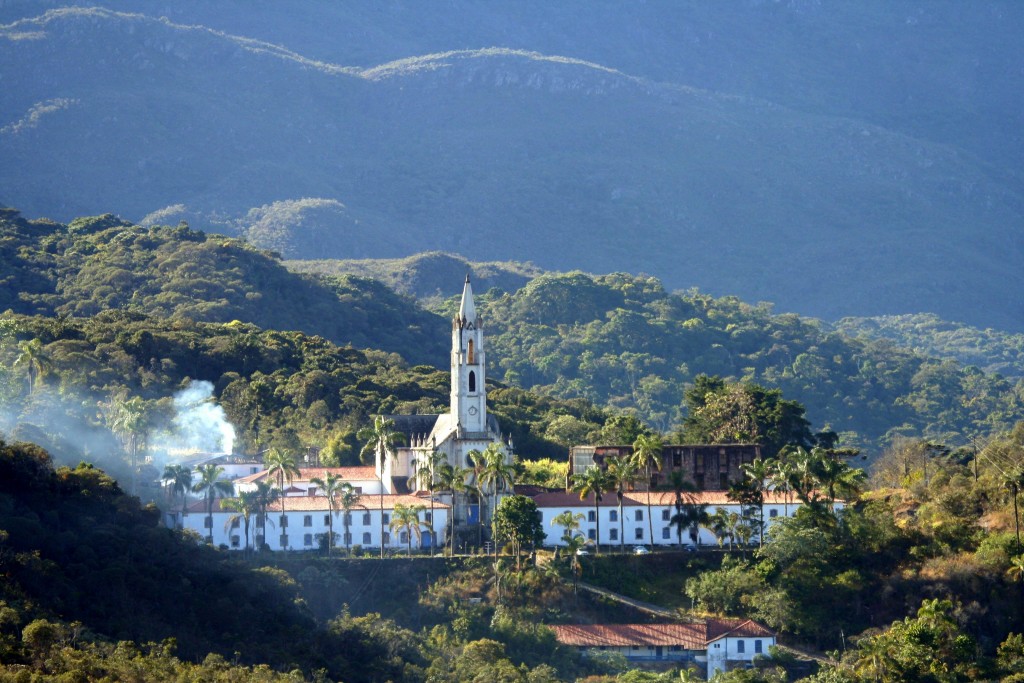
Caraca Hotel and Monastery
Caraca Park and Monastery is just an hour and a half out of Belo Horizonte, and if all had gone to plan I would have arrived at about 16.00. But after picking up Regina, who was to be my guide for the last few days, we got stuck for over two hours on the main road out of Belo after a bad accident blocked the road.
Caraca is surrounded by a national park. Its main mammalian claim to fame are the Maned Wolves that visit the patio each night to feed on food that the monks have been leaving out for the past 30 years.
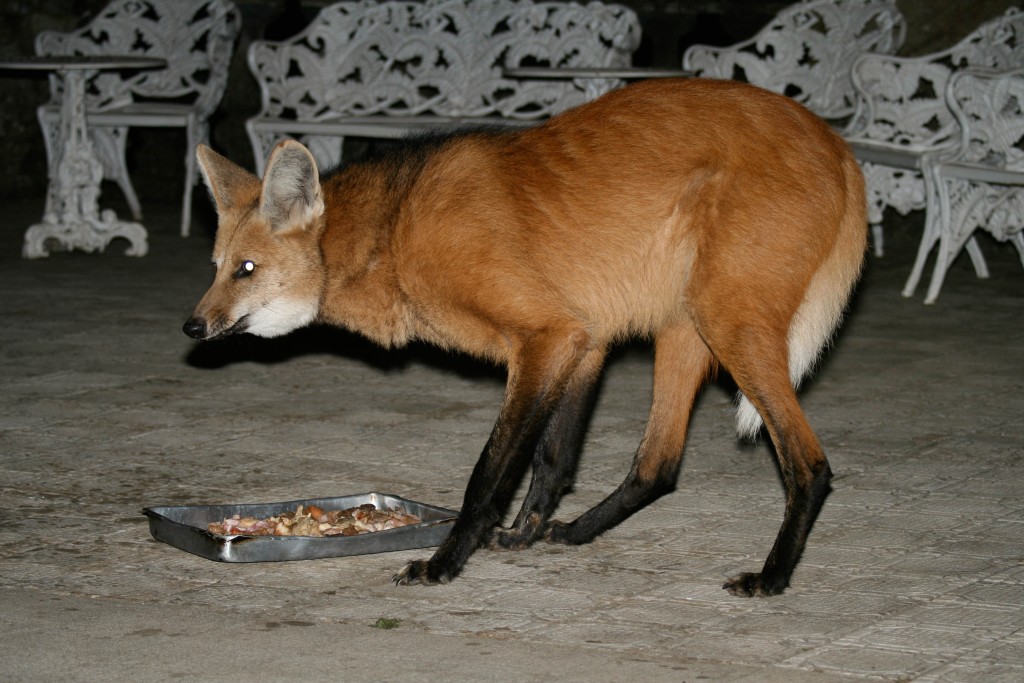
Maned Wolf, Chrysocyon brachyurus
We arrived 20.00 and a wolf had already been three times to feed. It was back 10 minutes later, but it was a Saturday and the place was crowded so it was more like a circus than a safari. I went back at 21.30 but there were still many families outside drinking wine and singing songs so I thought I’d postpone the wolf watching for the following night.
Day 14
Regina and I had a look around the carpark and garden at 6 a.m. the next morning. We found three Brazilian Guinea Pigs in the veggy garden (their usual haunt) and heard several groups of Black-fronted Titi Monkey’s calling (Callicebus nigrifons).
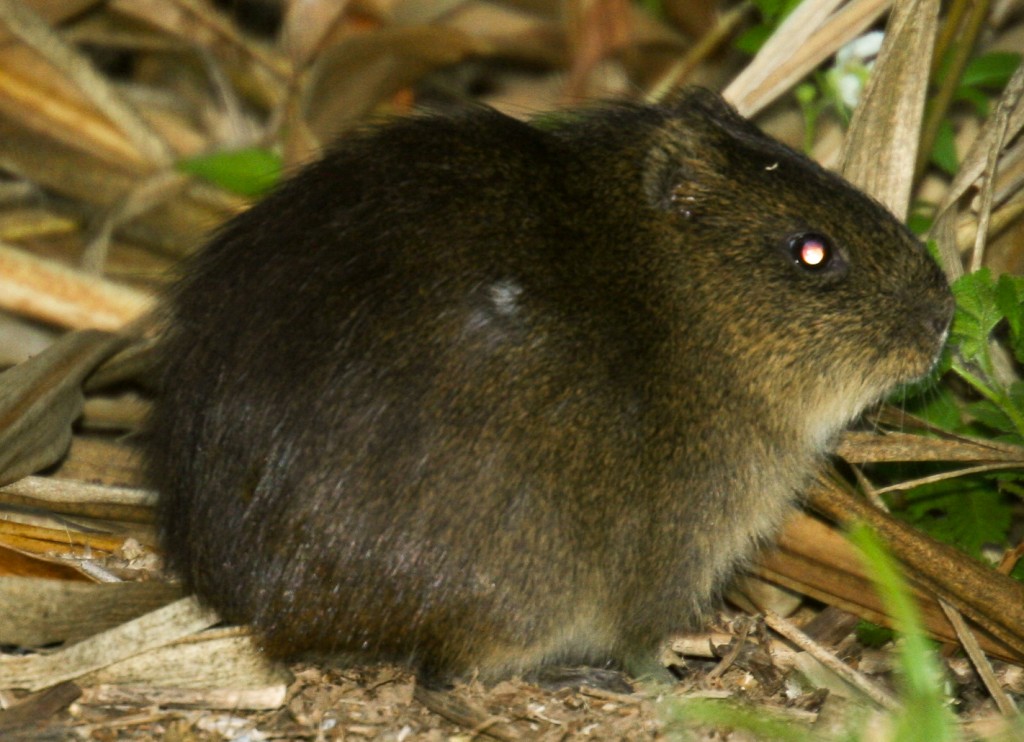
Brazilian Guinea-Pig, Cavia aperea
After brekky we headed along the short Tanque Grande Track. The track goes through prime titi habitat, and there are many trails branching off it that visitors are discouraged from using because they are for the park’s biologists. So, though we heard at least two groups of Black-fronted Titi Monkeys calling, it wasn’t until 10 a.m. that we saw a couple of animals. I got much longer views of these animals compared to the fleeting glimpses I’d had before of other titi species. But it was impossible to take decent pictures of them.
We headed back to the hotel carpark to look for Guianan Squirrels that are common there. But there was none to be seen. Heading back past the veggy garden I had a look in an old pig-sty, now some sort of a storage shed, and Regina spotted a squirrel inside that spent the next 10 minutes chewing on the walls and wooden railings. As we left the shed there was a Red Brocket Deer in the veggy garden.
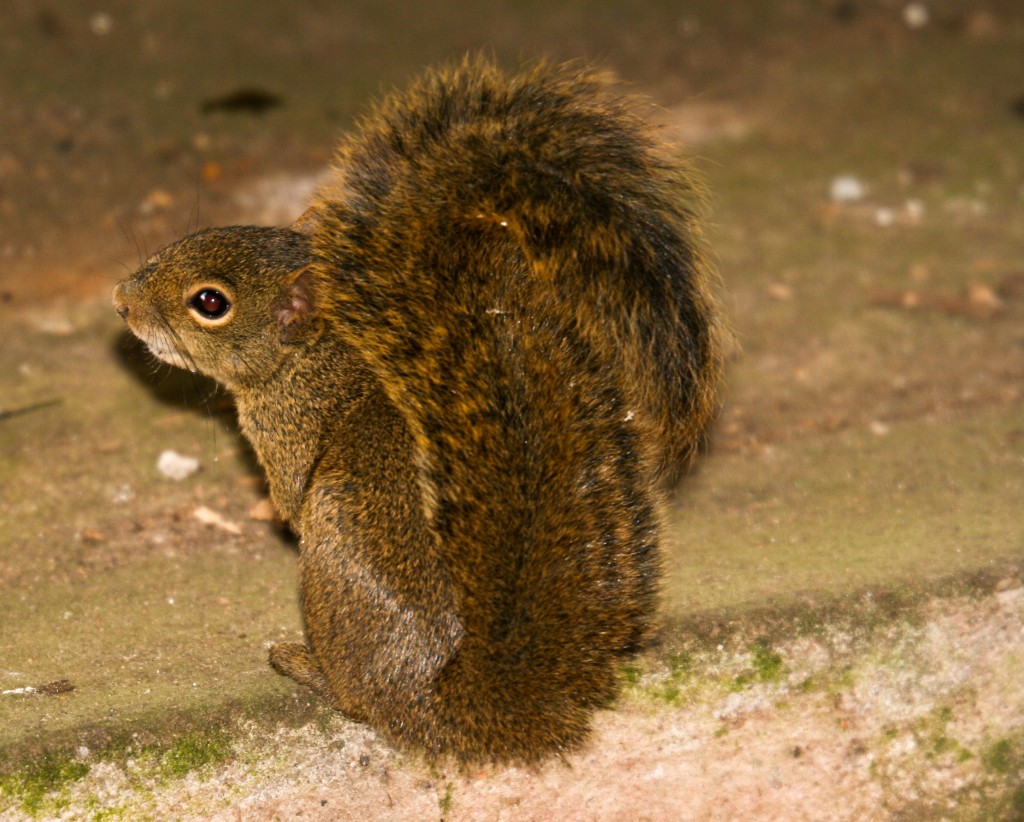
Guinean Squirrel, Sciurus aestuans
We spent the rest of the day exploring the forest behind the hotel, where Regina had once seen a Tayra. No luck. We also got permission to take a look in the roof space of the chapel to see a colony of Black Myotis bats that have roosted there for several years at least. Though we could hear plenty they were mainly hidden behind the wooden beams so the views were not great.
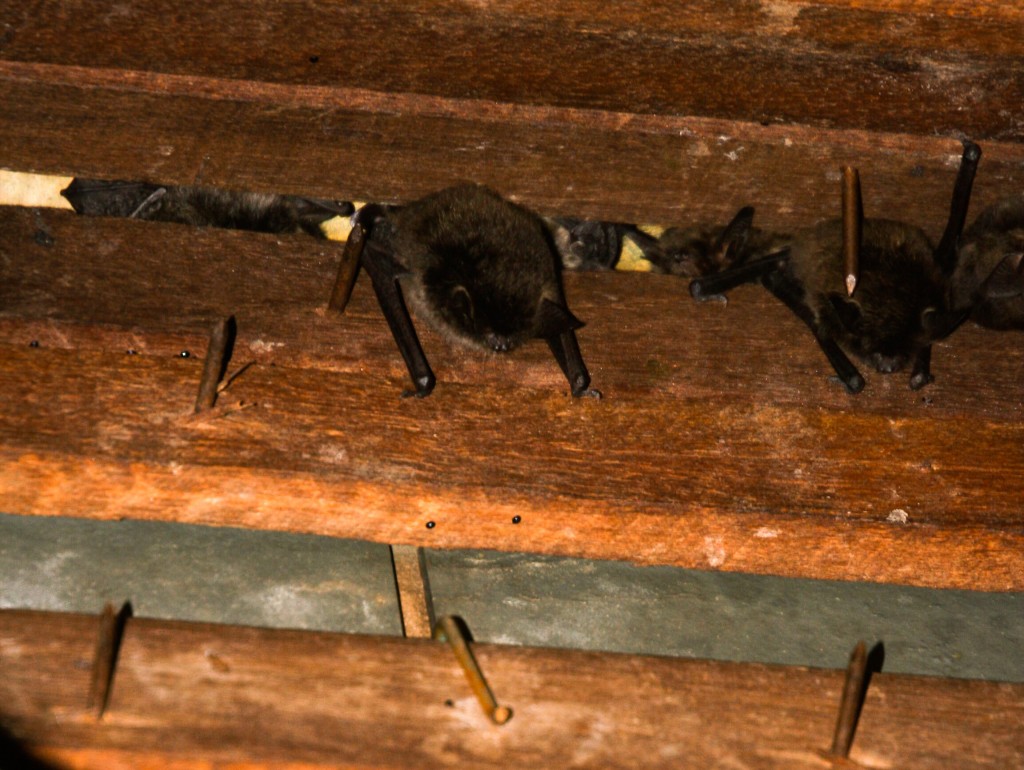
Black Myotis, Myotis nigricans
I photographed a second species in the roof. A recent fauna survey of the park had found three species of bats living in the chapel: Black Myotis, Brazilian Freetail and Eumops perotis (one of the Bonneted Bats). The second species I saw was clearly a molossid bat and too small, and the wrong biz, for Eumops, so almost certainly a Brazilian Freetail.
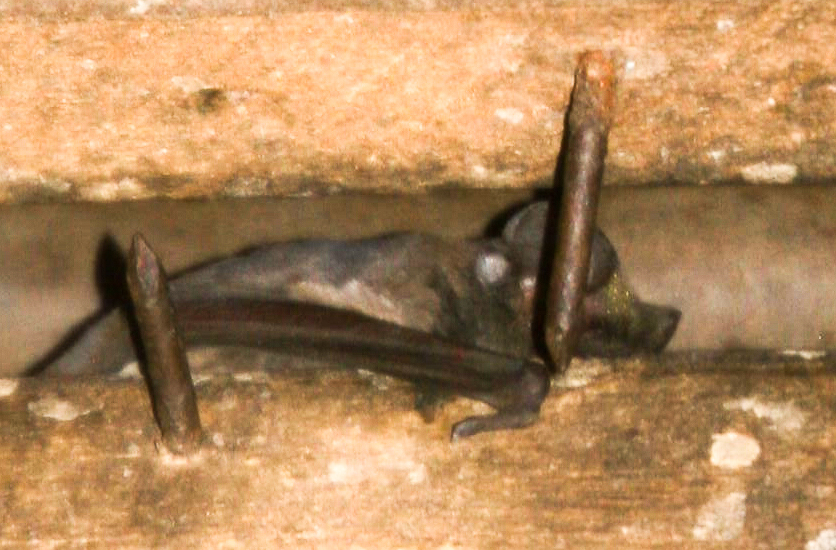
Brazilian Freetail Bat, Tadarida brasiliensis
After dinner we waited for the wolf. With only a handful of people left in the hotel on Sunday night it was a much better encounter when the wolf eventually arrived at a very cold 21.15.
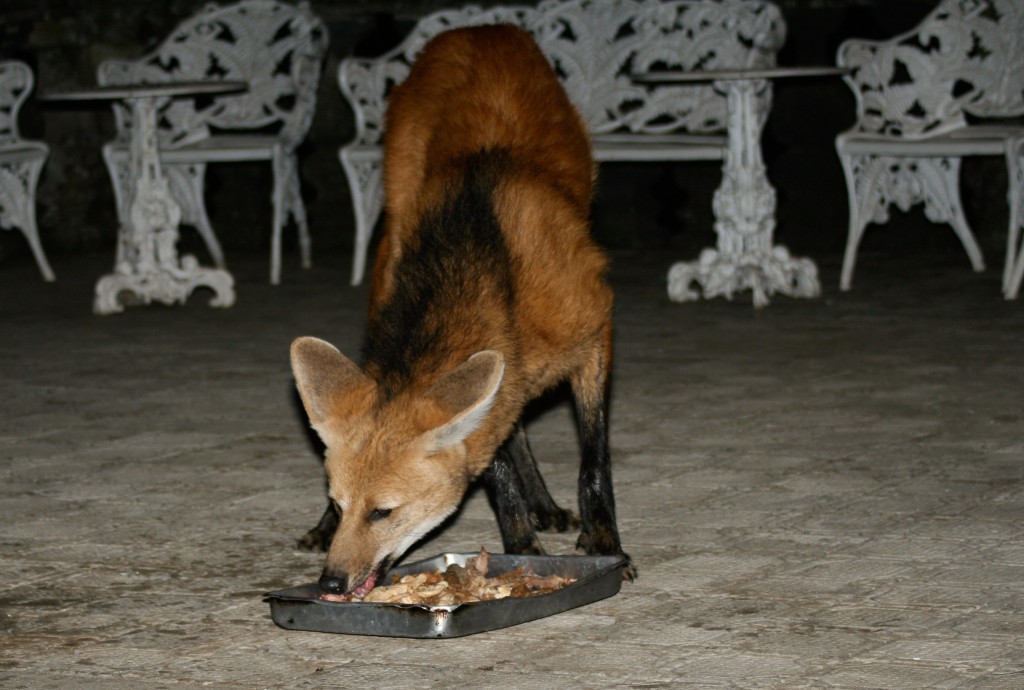
Maned Wolf, Chrysocyon brachyurus
I had a quick spotlight around the garbage cans in the picnic area adjoining the main car park, and the veggy garden too. Nothing happening.
Day 15
An early departure had us near Manhuacu by 11 a.m. Some friends of Regina – the Graciemas – have a smallholding here where they introduced a pair of Geoffroys Marmosets 30 years ago. A dozen or so were waiting for me when I arrived.
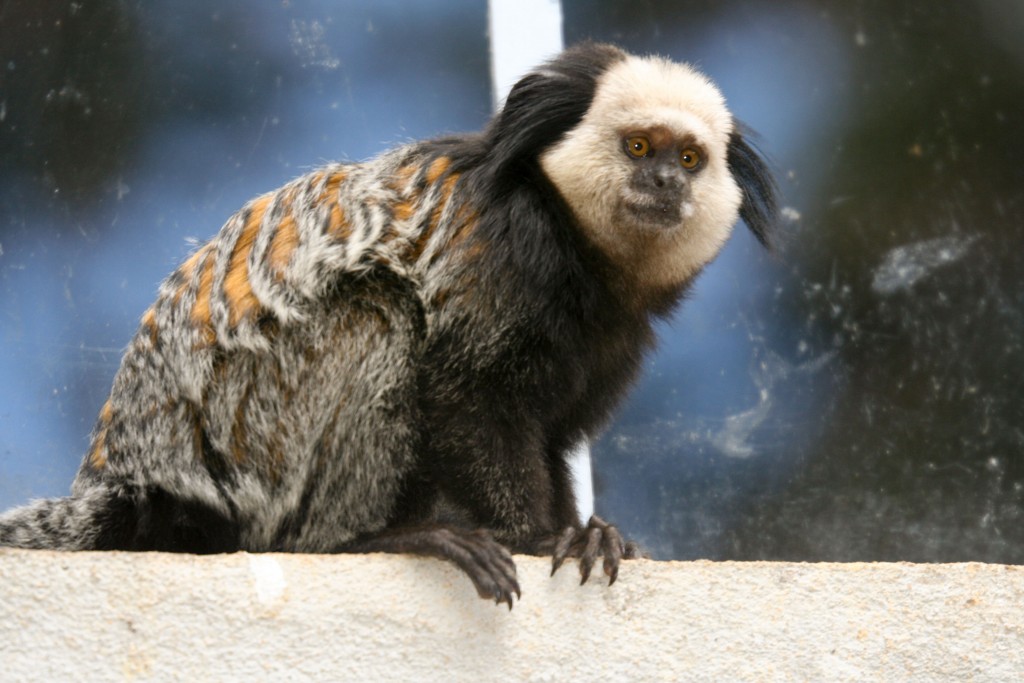
Geoffroy’s Marmoset, Callithrix geoffroyi
A deserted house on the other side of the highway from Sitio Graciema had a roost of Common Long-Tongued Bats, several of which were displaying their immensely long tongues.
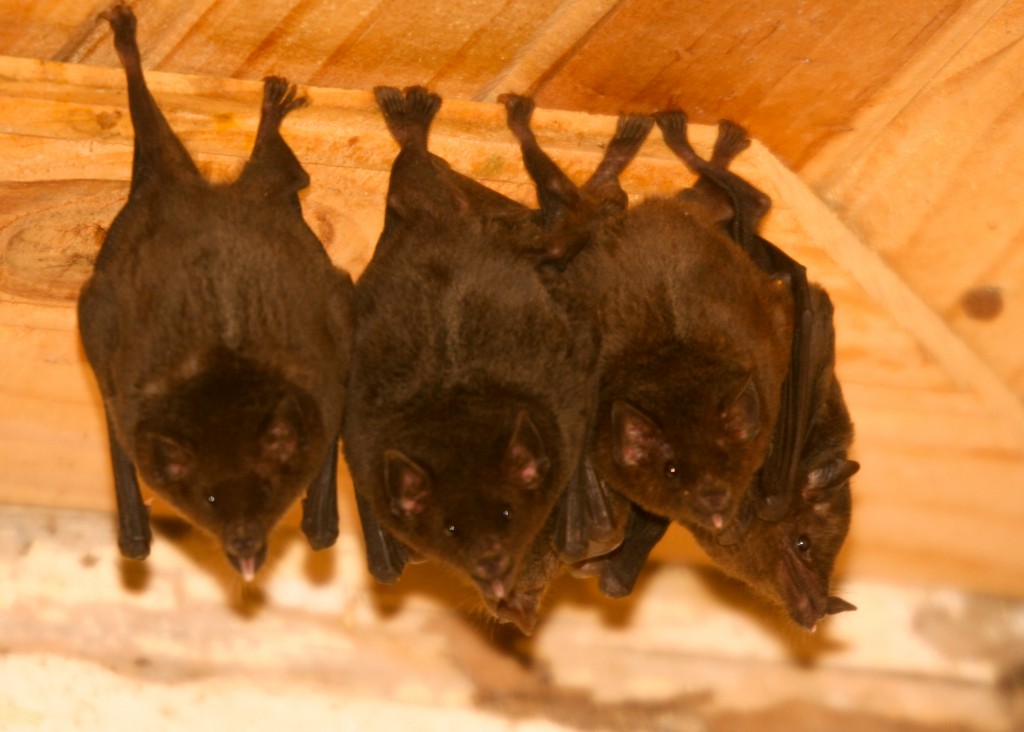
Common Long-tongued Bat, Glossophaga sorcina
From there it was another hour to the town of Caratinga and lunch, followed by a 40 minute drive to the edge of the Caratinga Sanctuary.
Caratinga Sanctuary
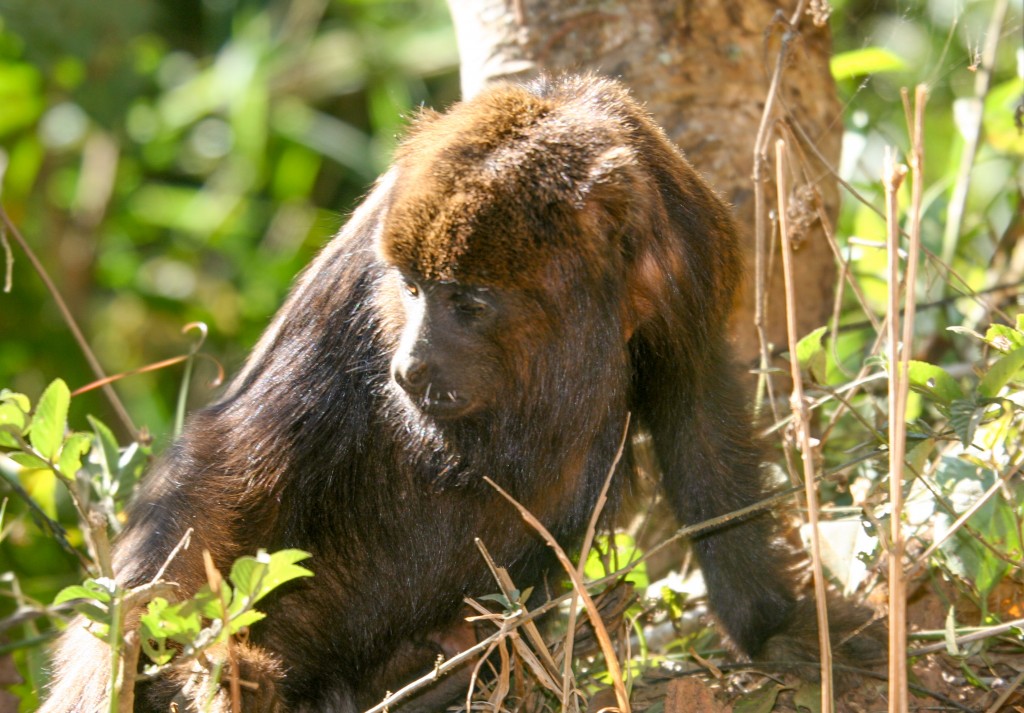
Brown Howler Monkey, Aloatta guariba
We spent the rest of the afternoon walking along the stretch of road just past the reserve’s signpost on the way from Caratinga town (and a few kms before the reserve HQ). This is a good place to find Buffy-Headed Marmosets but we didn’t find any that afternoon though we did see two groups of Brown Howlers. During a spotlight drive along the road towards the Park HQ and then back to Caratinga town we saw a couple of Brazilian Cavies and then a South-Eastern Common Opossum (Didelphis aurita) which looked a bit the worse for wear. We saw another one that had been squashed just a few minutes before so perhaps this is a good area to see these common animals.
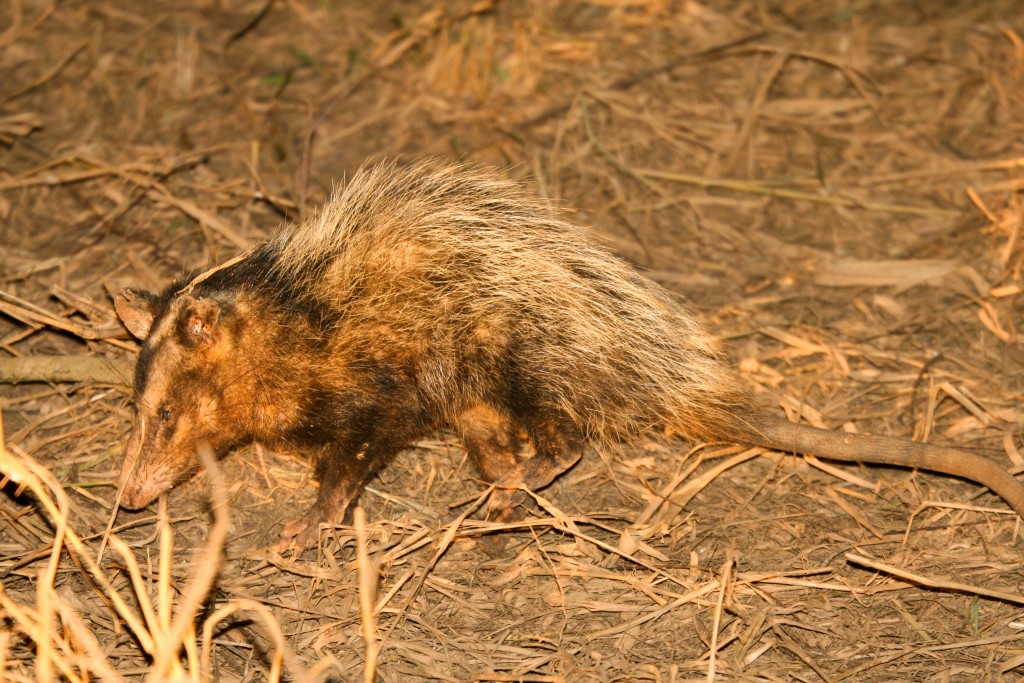
South-Eastern Common Opossum, Didelphis aurita
Day 16
We were back on the same stretch of road early the next morning and could hear the Buffy-Headed Marmoset’s faint hissing whistles. We saw a small group after about half and hour that was some way off the track and in a vine tangle. Close by was a Northern Black Tufted Capuchin that gave good views feeding on palm fruits (somewhat unusually this was the only Black Tufted Capuchin we were to see all day).
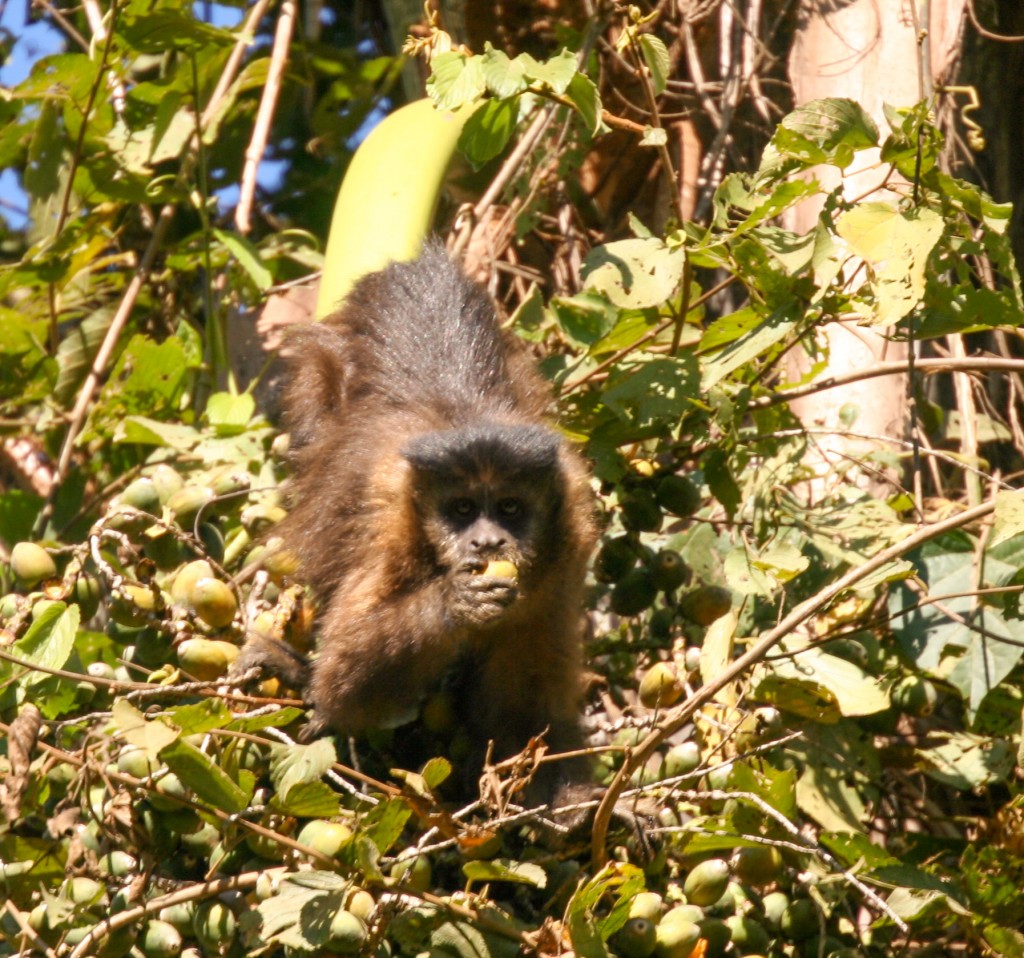
Black Tufted Capuchin, Cebus nigritus
We arrived at Caratinga Research Station at 10.00 and walked along the main track further into the forest. The walk was pretty quiet until we heard the patter of tiny feet in the forest. The patter became a charge and three Red-Rumped Agoutis shot out of the undergrowth and ran a few metres in front of us. Another emerged a few seconds later. Oblivious to us, he dashed up the road – running between Regina and me – and then headed off in the direction his mates had gone. My first agouti stampede.
I don’t know what spooked the animals but we found fresh shit on the road about 100 metres further on that had come from a largish carnivore (it could have been from a Puma for example – researchers had recently photographed a Puma with a camera trap). Another 100 metres further on we heard a panting-growling kind of a noise coming that was quite close. This sounded like the sort of noise that a howler monkey would be able to make should it choose to, but neither Regina nor Robert, the Caratinga Guide, had ever heard a howler making that sound before. So perhaps it was a Puma. Or perhaps a Tayra.
Three-Toed Sloths are seen every few weeks at Carting; perhaps because the trees are relatively short and there are some nice vantage points over the canopy. We put considerable effort into looking for them. No luck.
The Park’s 300 Northern Muriquis (Woolly Spider Monkeys) were surprisingly quiet and after lunch we headed to a different section of the park where researchers had been following a few of the monkeys. We had good views through the scope of a small group of these endangered animals feeding and travelling through the forest.
We also stopped at an abandoned house (not far off the entrance drive into the park) where a colony of Seba’s (I think) Short-Tailed Fruit bats were roosting. I idenitfied them to genus level by the large chin wart, surrounded with a U of smaller warts. So there you go!
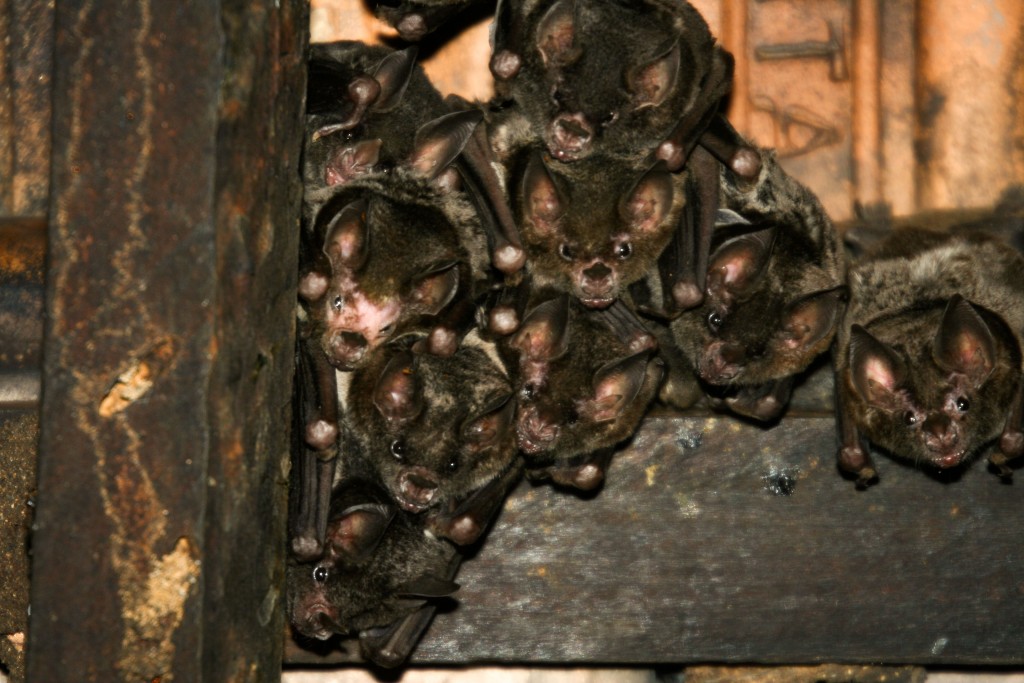
Seba’s Short-tailed Fruit Bat, Carollia perspicilliata
As we were leaving Caratinga I spotted a Brown Howler Monkey sitting by the road. After taking a few photos it was clear something was wrong with her and when Regina walked up to her she hobbled off the track leaving behind a tiny baby. The baby cried for a second and was then motionless. I thought it had died but when Regina returned with someone from park HQ he reunited mother and baby. The parent, still woozy from her apparent fall from a tree, was last seen feeding a few metres off the ground with her baby reattached.
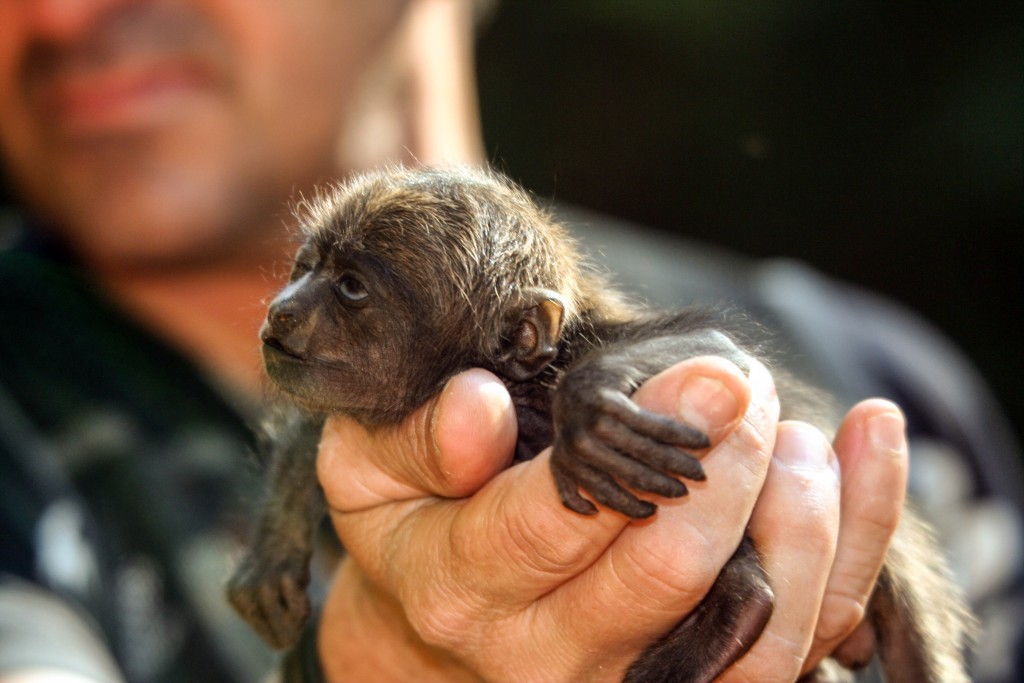
Woozy baby Brown Howler Monkey, Aloatta guariba
The five hour drive that evening to Santa Maria in Espirito Santo was uneventful.
Santa Maria Northern Muriqui Reserve
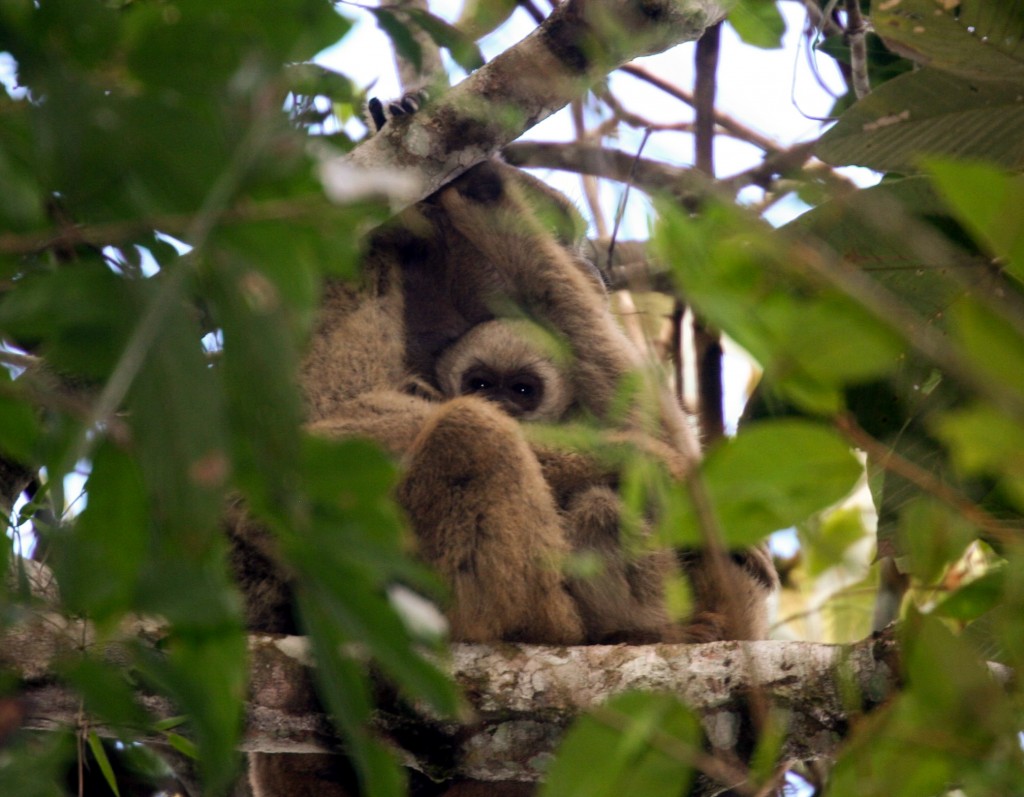
Northern Muriqui, Brachyteles hypoxanthus
Day 17
I spent my last morning’s mammal watching at the Muriqui Project near Santa Maria in Espirito Santo. Fewer than 20 Northern Muriquis live in a remnant 100 hectare patch of forest that is privately owned and isolated in a sea of eucalpyt trees. Because the forest is so small it’s a good place to see a few interesting species. Barbara, the researcher who showed me around, had seen Oncillas three times in a couple of years and many Tayras. Some of the smaller porcupine species sometimes fed near the house at night, while, judging from the diggings, the park’s armadillos were abundant (both Nine-Banded and Seven–Banded occur here).
I’d come primarily to see the park’s healthy population of Southern Maned Sloths, which like the Muriquis are endemic to Brazil’s Atlantic Rainforests (and in 2023 were split into a southern and northern species). Between 7.30 and 12.30 we saw four animals. One was feeding, one sunbathing and the other two just hanging (apparently some of the animals are primarily diurnal and others primarily nocturnal).
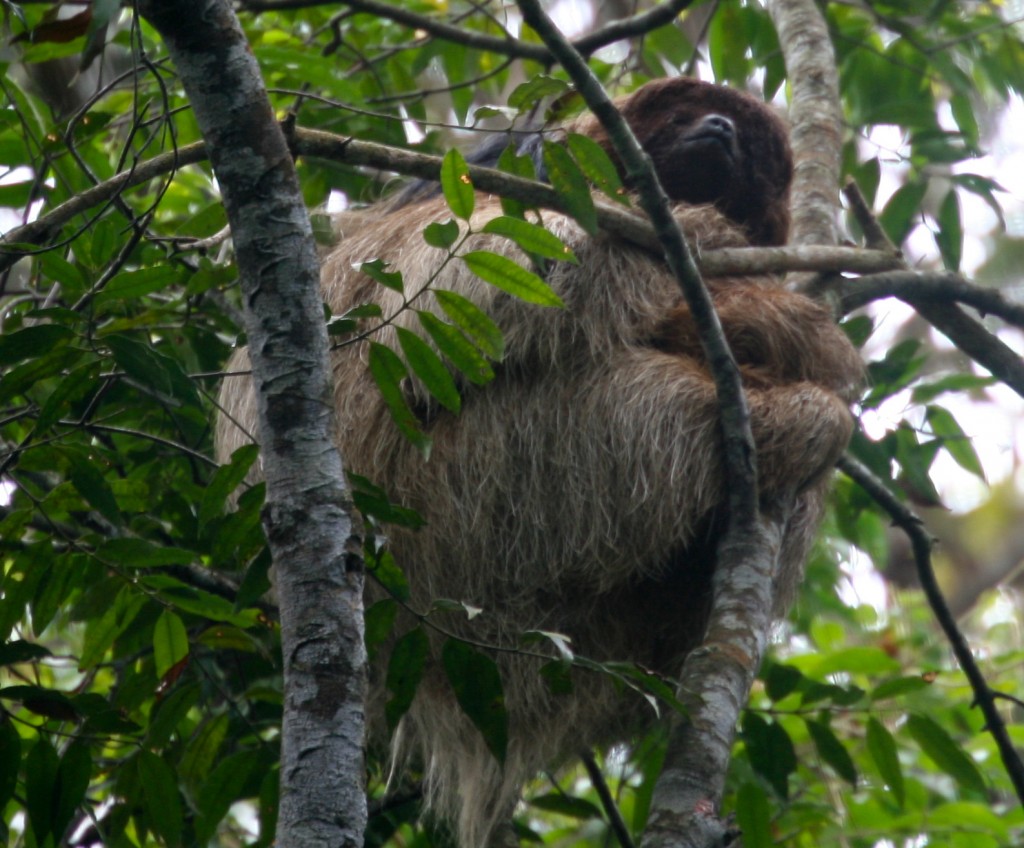
Southern Maned Sloth, Bradypus crinitus
During the morning’s walk we also saw two Guianan Squirrels, a very large Buffy-Headed Marmoset and a Buffy-headed* Geoffroy’s Marmoset hybrid. We also had much better views than we had had the day before of several Muriquis. Brown Howlers were common.
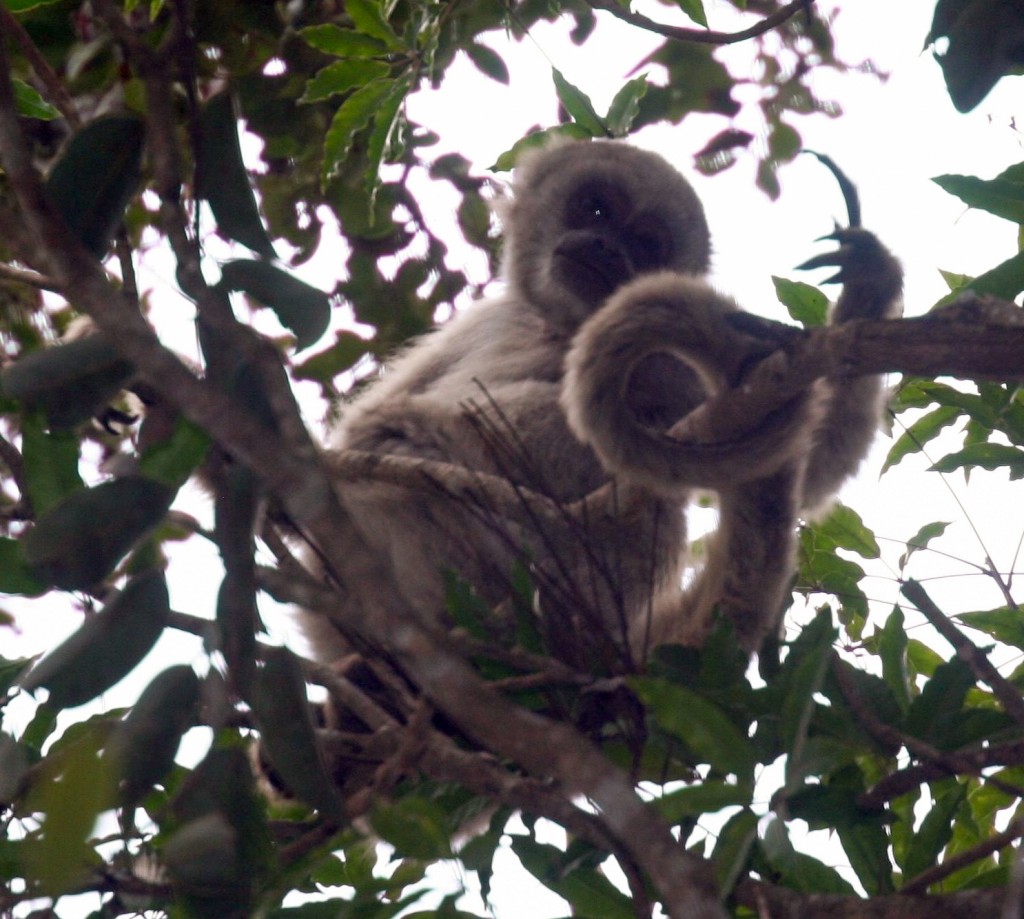
Juvenile Northern Muriqui, Brachyteles hypoxanthus
It was again a quite quiet morning for primates and I was disappointed not to hear or see more Masked Titi monkeys here (C. personatus and now a different species to what they have in Caraca), nor any Geoffroy’s Marmosets.
The two hour drive on to Vitoria and my plane to Sao Paulo was again mammal free, though the hood of the rental car didn’t shut properly and blew open, taking the windshield with it, as we left Santa Maria. This made for some excitement.
Stuff I Missed
Again I saw all that I hoped to see in Minais Gerais. There was always a chance for a Tayra or a Jaguarundi and I think we were pretty close to a Puma in Caratinga but they were always long-shots. Primates were definitely easier to see in the mornings in the forest while I was there.
An excellent 2.5 weeks. The 53 confirmed species I identified – quite a lot more than I had expected – were nearly all lifers. And then of course there is the beauty of the landscape, the friendliness of the Brazilian people, the cheapness of the alcohol and the joys of freshly cooked cheesebread for breakfast. Who could want anything more.
Species List
1. Common (Grey) Four-eyed Opossum Philander canus – one near Araras during a night drive at 20.00; another (probably the same animal) at 22.00 the next evening.
2. South Eastern Common Opossum Didelphis aurita – one on the road near the Caratinga Reserve at 18.30 (another freshly squashed a few kms further on).
3. Nine-banded Armadillo Dasypus novemcinctus – one while spotlighting on foot in the forest behind Pousada Jaguar; two during a spotlight walk along the Araras boardwalk at midnight.
4. Giant Anteater Myrmecophaga tridactyla – one on the road at 21.00 near Araras lodge; another at 16.00 on the drive out from the Rio Claro Hotel; one at 21.30 on the Santa Isabel Road; one at 21.00 near Araras; seven in Canastra National Park during the day.
5. Southern Tamandua Tamandua tetradactyla – one on the road at 20.45 near Araras lodge; another on the road at 21.30 near the Rio Pixiam; one at 22.00 just south of Araras; on at 21.00 on the Passo Da Ema near Araras.
6. Southern Maned Sloth Bradypus crinitus – four at the Santa Maria Muriqui Project.
7. Forest Rabbit (Tapiti) Sylvilagus brasiliensis – one at night along Santa Isabel Road; another at dusk on the Santa Isabel Road; one near Araras at night.
8. Guianan Squirrel Sciurus aestuans – one in a shed near the vegetable garden at Caratinga at 11.00; two at the Santa Maria Muriqui reserve.
9. Azara’s Agouti Dasyprocta azarai – one at 09.00 in Porto Jofre; two at 09.00 in the forest behind Pousada Jaguar; one at 17.00 on the Santa Isabel Road; common in Araras along the boardwalks.
10. Red-Rumped Agouti Dasyprocta leporina – a group of four ran across the road in the Caratinga Reserve at 11.00.
11. Paca Cuniculus paca – two seen along the river after dark at Rio Cristalino.
12. Brazilian Guinea-Pig Cavia aperea – three in the vegetable garden at Caraca at 06.30; two on the road just after dark near Caratinga.
13. Capybara Hydrochoerus hydrochaeris – a few at Rio Cristalino (along the river and in the garden of the lodge); very common in the Pantanal.
14. Ocelot Felis pardalis – one at 21.00 near the Rio Pixiam; one at 18.30 about 5km north of Porto Jofre.
15. Margay Felis wiedii – possibly one at 20.30 about 300 metres south of Pousada Jaguar.
16. Jaguar Panthera onca – two on the bank of the river Cuiaba about 15 minutes downstream of Porto Jofre at 17.30.
17. Maned Wolf Chrysocyon brachyurus – two sightings in Canastra NP near the Corral do Pedro – one at 08.00 the other at 17.00, possibly the same animal; one came to take food at Caraca early on the first evening and one came at 21.30 on the second evening.
18. Crab-eating Fox Cerdocyon thous – 10 seen during the night drive from Pocones to Rio Claro; two seen during the night drive around Rio Pixiam; one behind Pousada Jaguar at 22.00; very common around Araras (eg 10 during the first night drive from Araras).
19. Neotropical River Otter Lutra longicaudis – one at Rio Cristalino in the late afternoon, upstream of the lodge; at least one (possibly 3) during the dawn boat trip along the Rio Claro; one at 09.00 from the banks of the Rio Pixiam.
20. Giant Otter Pteronura brasiliensis – a family of 7 during the dawn boat trip along the Rio Claro; two groups of at least 5 on the Rio Cuiaba and Rio Piquiri during the boat trip from Porto Jofre between 16.00 and 17.00.
21. South American Coati Nasua nasua – one at 17.00 about 25km south of Rio Pixiam; one at the start of the Santa Isabel road at 18.30; one on the Araras boardwalk at 16.00; a group of 8 near Araras in the early morning; at least two on the same block (Passo Da Ema) later in the afternoon and at night.
22. Crab-eating Raccoon Procyon cancrivorus – three during the night drive from the start of the Transpantaneira to Rio Claro; six during the first night drive from Arara; three during the second Araras night drive.
23. Long-nosed Proboscis Bat Rhynchonycteris naso – 15 or so roosting on a tree overhanging the river at the Rio Claro Hotel.
24. Lesser White-lined Bat Saccopteryx leptura – 10 or so roosting under the eaves of the roof in the building next to the office/library at Rio Cristalino.
25. Lesser Fishing Bat Noctilio albiventris – dozens flying along the Rio Pixiam and Rio Cuiaba (Porto Jofre) shortly after dusk.
26. Greater Fishing Bat Noctilio leporinus – probably one flying through the covered patio at the Hotel Matto Grosso on the Rio Pixiam; several feeding along the river at dusk at Porto Jofre.
27. Common Long-tongued Bat Glossophaga sorcina – a group of 30+ roosting in an abanonded house at Sitio Graciema.
28 Seba’s Short-tailed Fruit Bat Carollia perspicilliata – roosting in an abandoned house at Caratinga.
29. Inca Broad-nosed Bat Platyrrhinus incarum – one at Pousada Jaguar.
30. Flat-faced Fruit-eating Bat Artibeus jamaicensis – two at Araras.
31. Pallas’s Mastiff Bat Molossus molussus – roosting in the roof at Pousada Jaguar.
32. Black Myotis Myotis nigricans – a few seen in the chapel roof at Caraca, many others heard.
33. Brazilian Free-tailed Bat Tadarida brasiliensis – one photographed in the roof space of the chapel at Caraca.
34. Buffy-headed Marmoset Callithrix flaviceps – a small group early in the morning along the road into Caratinga, at least one (along with a flaviceps/geoffroyi hybrid) in the Santa Maria Muriqui reserve at 10.00.
35. Geoffroy’s Marmoset Callithrix geoffroyi – 15 or so at Sitio Graciema.
36. Black-tailed (Pantanal) Marmosets Callithrix melanura – two groups along the Rio Claro early in the morning during the boat ride; another group while walking the trail along the river later that morning; a group alongside the road about 10 km south of Rio Pixiam at 16.30.
37. Black-tufted Marmoset Callithrix penicillata – a group of 20 or so taking food from the hand in the back yard of the Hotel Chapadão da Canastra in Sao Roque de Minas; one along the Tanque Grande trail at Caraca at 09.00.
38. Brown Tufted Capuchin Cebus apella – quite common near the Cristalino lodge.
39. Hooded (Azara’s) Capuchin Cebus cay – a few animals along the Rio Claro early in the morning; another small group close to the Rio Pixiam (seen while walking the trail from the hotel along the river); another about 35 km south of Rio Pixiam at 17.30; many around Pousada Jaguar and along the river from Porto Jofre; many at Araras.
40. Northern Black Tufted Capuchin Cebus nigritus – surprisingly not all that easy to see at Caratinga. I saw one along the road on the way in, but none while walking the trails at Caratinga.
41. Azara’s Night Monkey Aoutus azarai – several in the trees near the Cristalino lodge at 19.00.
42. Dusky Titi Monkey Callicebus moloch – a small group eventually tracked down in Rio Cristalino near the start of the Dr Haffer’s Trail at about 08.00.
43. Black-fronted Titi Monkey Callicebus nigrifons – several groups heard along the Tanque Grande Trail at Caraca between 06.00 and 09.00, two of which were seen.
44. White-nosed Bearded Saki Chiropotes albinasus – two largish groups close to the Cristalino lodge in the morning.
45. White-Whiskered Spider Monkey Ateles maginatus – common at Rio Cristalino both along the river and very close to the lodge.
46. Northern Muriqui Brachyteles hypoxanthus – half a dozen at Cartinga and another four animals in the Santa Maria Muriqui reserve.
47. Red-handed Howler Alouatta discolor – one group of about 10 animals about 1 km from the Cristalino Lodge (along the Rocky Trail) at 08.00.
48. Black Howler Alouatta caraya – two groups during the dawn boat trip along the Rio Claro; another group along the Rio Pixiam Trail at about 08.00; many around Pousada Jaguar and along the river from Porto Jofre; common at Araras.
49. Brown Howler Monkey Aloatta guariba – several groups in Caratinga; several groups in the Santa Maria Muriqui Reserve.
50. Pampas Deer Ozotoceros bezoarticus – one in Canastra National Park at about noon.
51. Red Brocket Deer Mazama americana – one near to Araras lodge at night; another at 16.00 leaving the Rio Claro Hotel; several near Pousada Jaguar; one in the vegetable garden at Caratinga at 11.00.
52. Grey Brocket Deer Mazama gouazoupira – one early in the morning along the Dr Haffer’s Trail at Cristalino; one on the Santa Isabel Road.
53. Marsh Deer Blastocerus dichotomus – common (both day and night time) along the Transpantaneira.
54. Brazilian Tapir Tapirus terrestris – one from the saltlick hide at 21.00 at Cristalino; another about 3 km upstream of Cristalino lodge at 17.00; two along the Santa Isabel Road during my first night drive out of Pousada Jaguar; three along the Santa Isabel Road during the second night drive; one during the first night drive out of Araras; one during the second night drive.
3 Comments
Leave a Reply
You must be logged in to post a comment.


MBatora
Do you happen to still have contact details of your guide in Santa Teresa? I will be in the area the next few months and would love to see the sloths and muriquis there. I cannot find information on ecotourism in that place, though. Or would you recommend to contact Regina Ribeiro for visiting there?